Chess Notes
Edward Winter
When contacting us by e-mail, correspondents are asked to include their name and full postal address and, when providing information, to quote exact book and magazine sources. The word ‘chess’ needs to appear in the subject-line or in the message itself.
| First column | << previous | Archives [152] | next >> | Current column |
10362. Photographs from The Tatler and The Bystander
Gerard Killoran (Ilkley, England) has provided these photographs:
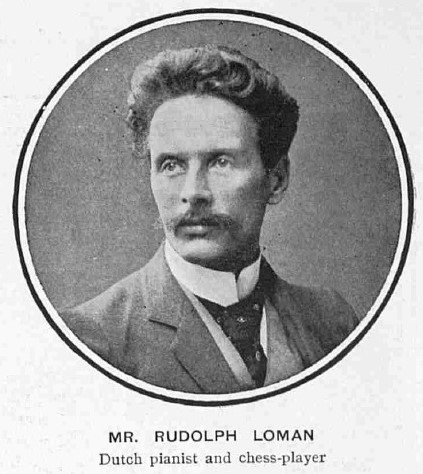
The Tatler, 12 March 1902, page 468
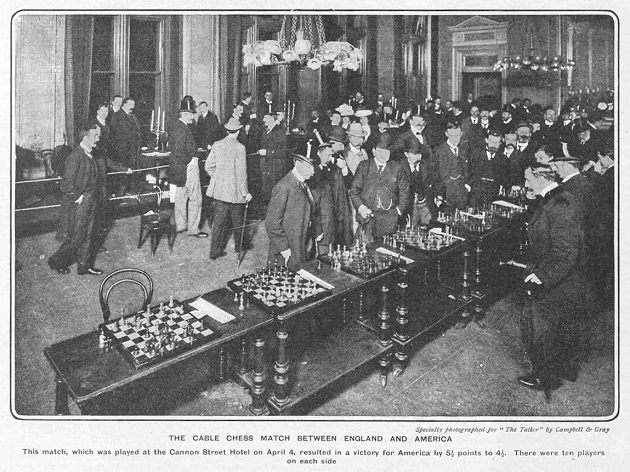
The Tatler, 15 April 1903, page 84
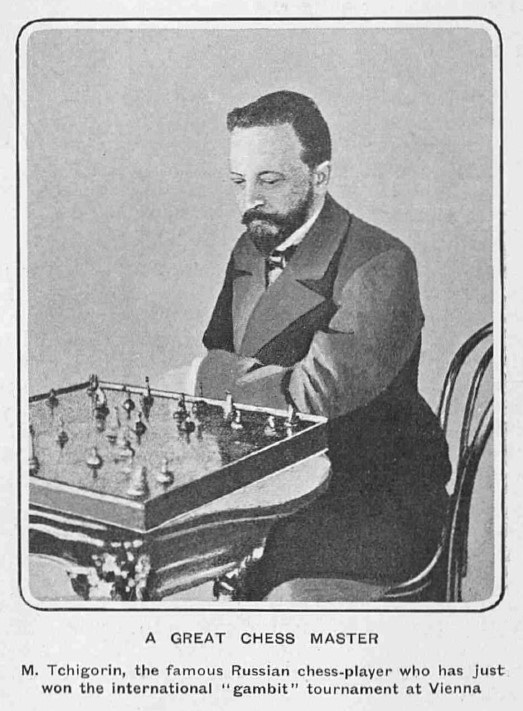
The Tatler, 3 June 1903, page 350
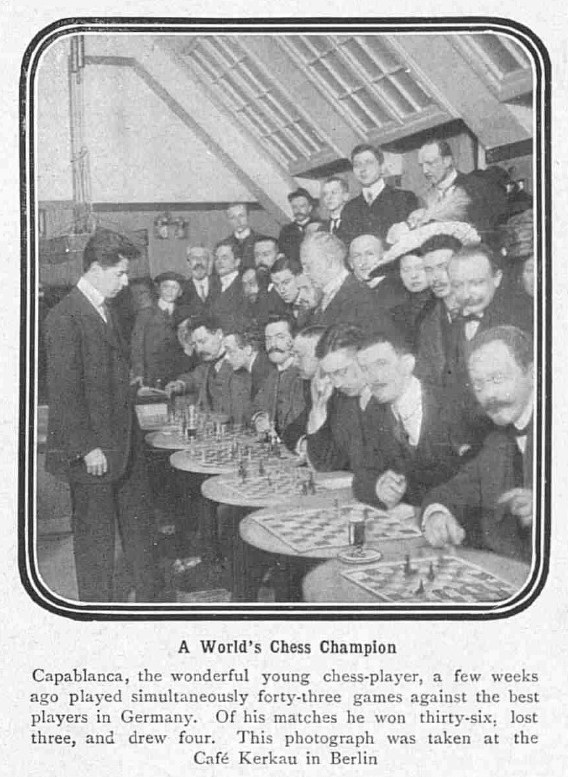
The Bystander, 17 May 1911, page 340
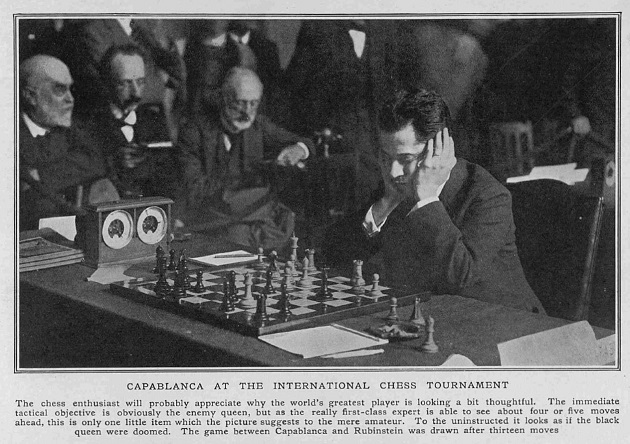
The Tatler, 23 August 1922, page 285
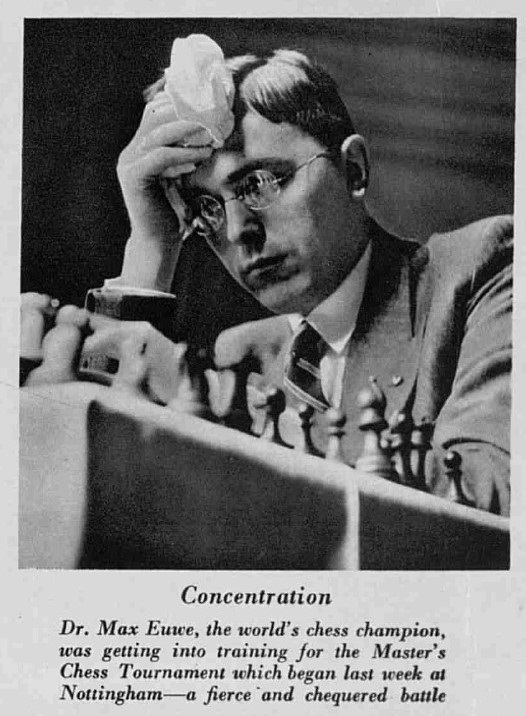
The Bystander, 19 August 1936, page 314.
Caption information is not always reliable, of course. For example, Mr Killoran notes that in the London, 1922 photograph Capablanca was playing not Rubinstein but Vidmar, and was reflecting on his reply to 14...Qb4.
From page 226 of Capablanca’s A Primer of Chess (London, 1935):
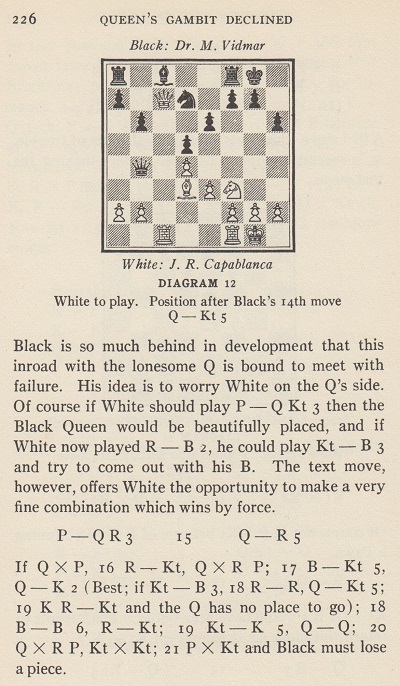
10363. Euwe v Alekhine match, 1937
Regarding the 1937 Euwe v Alekhine world championship match, C.J.S. Purdy wrote on page 80 of Chess World, 1 May 1946:
‘Although for sheer accuracy it could not compare with the Alekhine-Capablanca match, it was, on the whole, the greatest chess match ever played.’
10364. En passant (C.N.s 3139 & 9083)
On the topic of an en passant capture giving mate, Christian Sánchez (Rosario, Argentina) draws attention to page 24 of The Delights of Chess by Assiac (London, 1960), which had the conclusion of a game won by T.T. Godwin:
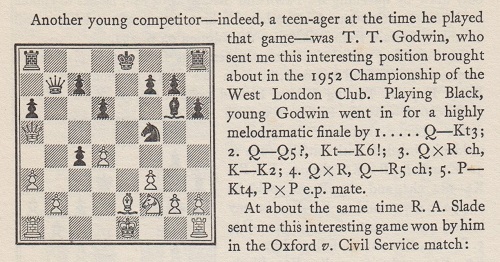
1...Qb6 2 Qd5 Ne3 3 Qxa8+ Ke7 4 Qxh8 Qa5+
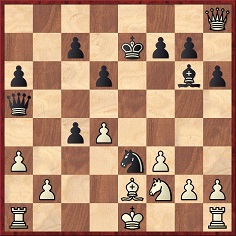
5 b4 cxb3 mate.
10365. Soldatenkov (C.N.s 6138 & 6144)
Two correspondents have recently submitted material on Vassily/Basil Soldatenkov, and for ease of reference we have first of all brought together C.N.s 6138 and 6144 in a feature article about him.
C.N. 6138 included the following information:
Soldatenkov also has a bearing on the origins of the Marshall Gambit in the Ruy López. At New York, 1918 Marshall played 8...d5 twice, against Capablanca and Morrison. Regarding the latter game it was pointed out on page 276 of the December 1918 American Chess Bulletin (under the heading ‘Duplication of Game after 17 Years’) and on page 21 of the tournament book that a game Sittenfeld v Soldatenkov, Paris, 1901 had followed Morrison v Marshall as far as move 18 (when Soldatenkov played ...Bd6 instead of ...gxf6). Whereas Marshall’s victory took 84 moves, Soldatenkov won in 25.
Tony Gillam (Nottingham, England) notes that the Sittenfeld v Soldatenkov game had been published too in the Brooklyn Daily Eagle, 22 November 1918, Section 1, page 2:

Mr Gillam also draws attention to a photograph (Le Mans, 1913) at the Gallica website.
John Hilbert (Amherst, NY, USA) takes up another point in C.N. 6138, where we wrote:
The New York Times (15 October 1917, page 16) reported that a Marshall/Soldatenkov v Janowsky/Jaffe consultation game had just begun (‘The contest will probably extend over the greater part of the week. Marshall and Soldatenkov, playing the white pieces, elected a queen’s pawn opening, to which the rival pair replied with knight to king’s bishop third.’). Further information would be welcome.
Dr Hilbert provides the following from page 15 of the Washington Evening Star, 22 October 1917:
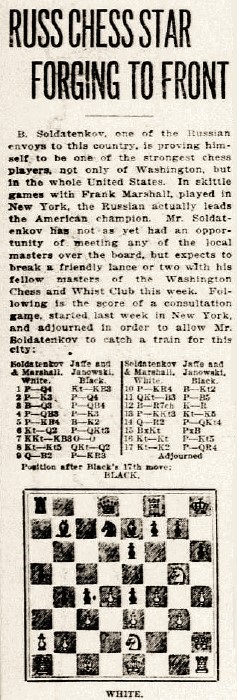
1 d4 Nf6 2 e3 d5 3 Bd3 c5 4 c3 e6 5 f4 Be7 6 Nd2 b6 7 Ngf3 O-O 8 Ng5 Nbd7 9 Qc2 h6
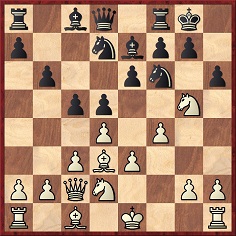
10 h4 Bb7 11 Ndf3 c4 12 Bh7+ Kh8 13 g3 Ne4 14 Qh2 b5 15 Bxe4 dxe4 16 Ng1 b4 17 Ne2 a5 Adjourned.
Whether the game was ever resumed has not been ascertained.
C.N. 6138 also mentioned that page 25 of the February 1922 American Chess Bulletin published a loss by Soldatenkov to Zirn in the Metropolitan Chess League. John Hilbert adds that the score had appeared on page A3 of the Brooklyn Daily Eagle, 23 February 1922:

Soldatenkov v Zirn: 1 d4 d5 2 Nf3 Nf6 3 c4 e6 4 Nc3 Nbd7 5 cxd5 exd5 6 Qb3 c6 7 e4 Qb6 8 e5 Qxb3 9 axb3 Ng8 10 Bd3 Ne7 11 O-O Ng6 12 Ng5 h6 13 Ne6 fxe6 14 Bxg6+ Kd8 15 Be3 Be7 16 f4 Nf8 17 Bd3 Bd7 18 g4 g6 19 Na4 Kc7 20 Bd2 h5 21 gxh5 Rxh5
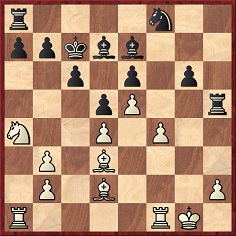
22 Nb6 Re8 23 Nxd7 Nxd7 24 Rxa7 c5 25 Rfa1 Reh8 26 Ba6 Rxh2 27 Ba5+ Kb8
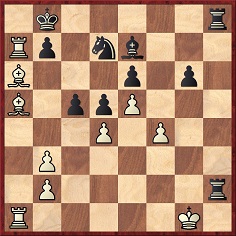
28 Bf1 Rh1+ 29 Kg2 R8h2+ 30 Kg3 Bh4+ 31 Kg4 Rg1+ 32 Kf3 Rg3 mate.
10366. Taffs (C.N. 10333)
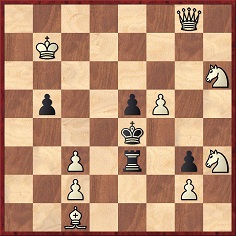
Mate in two
The problem in C.N. 10333 as published on page 25 of the Observer, 6 June 1926:
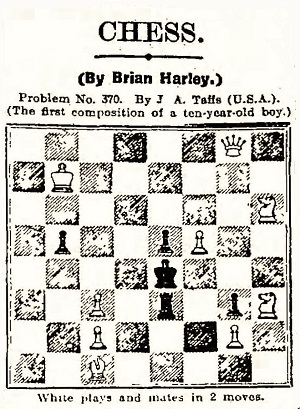
Taffs was also mentioned in a brief feature on page 6 of the 1 December 1931 edition of the Burlington Free Press:
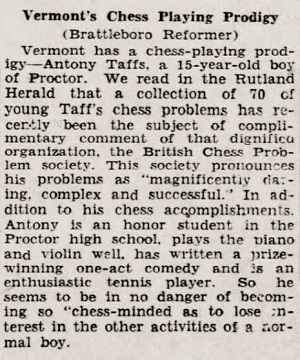
From the Battle Creek Enquirer, 17 January 1960, page 2, Section 3:
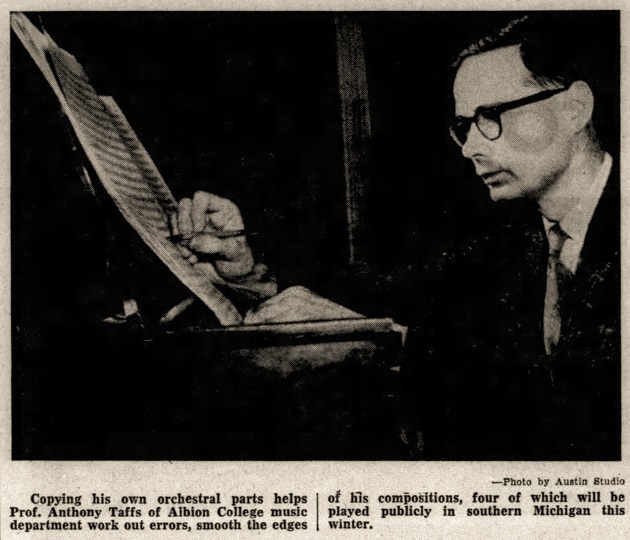
10367. Arthur John Curnock (C.N.s 9022 & 9032)
The ‘party trick’ problem in C.N.s 9022 and 9032 was accompanied on page 538 of the December 1902 BCM by another composition by Curnock:
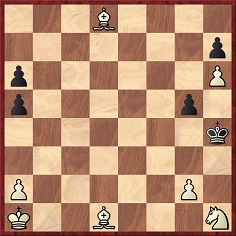
White mates in seven moves
The problem can be found, without a source, on page 179 of The Fireside Book of Chess by I. Chernev and F. Reinfeld (New York, 1949).
10368. Another selection of photographs
The pictures below have been forwarded by Olimpiu G. Urcan (Singapore):
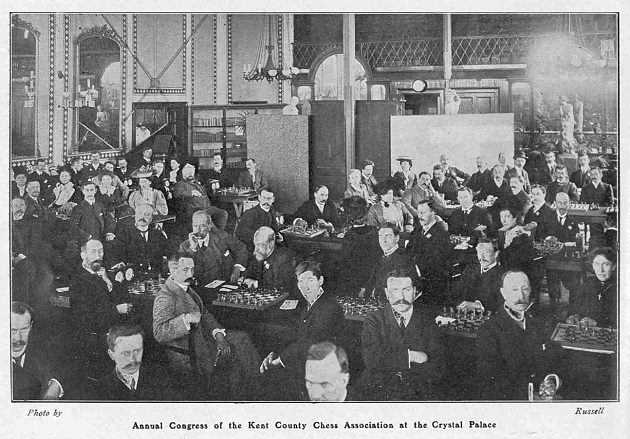
The Bystander, 21 June 1905, page 584
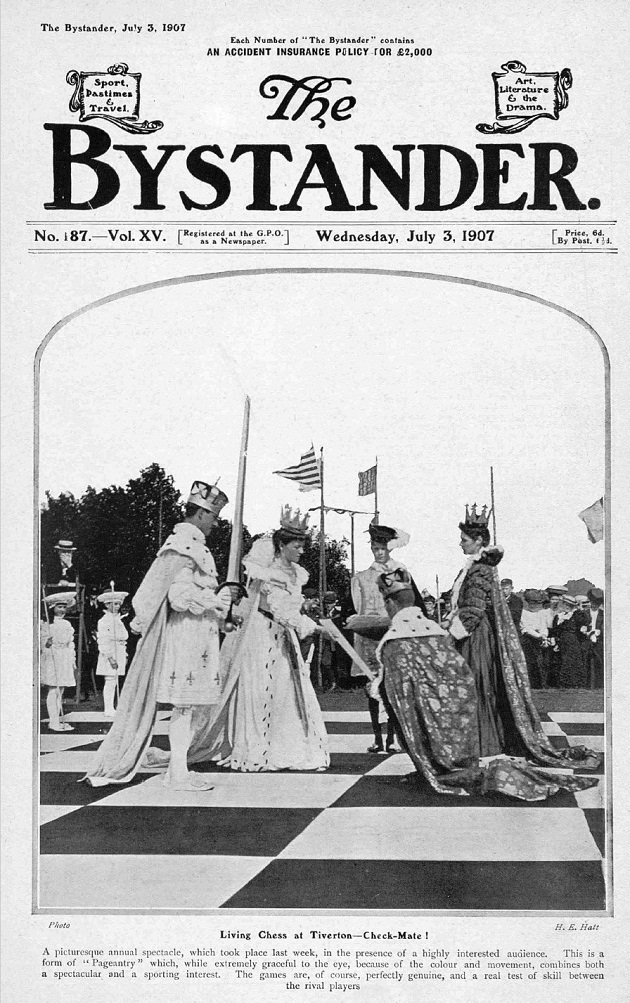
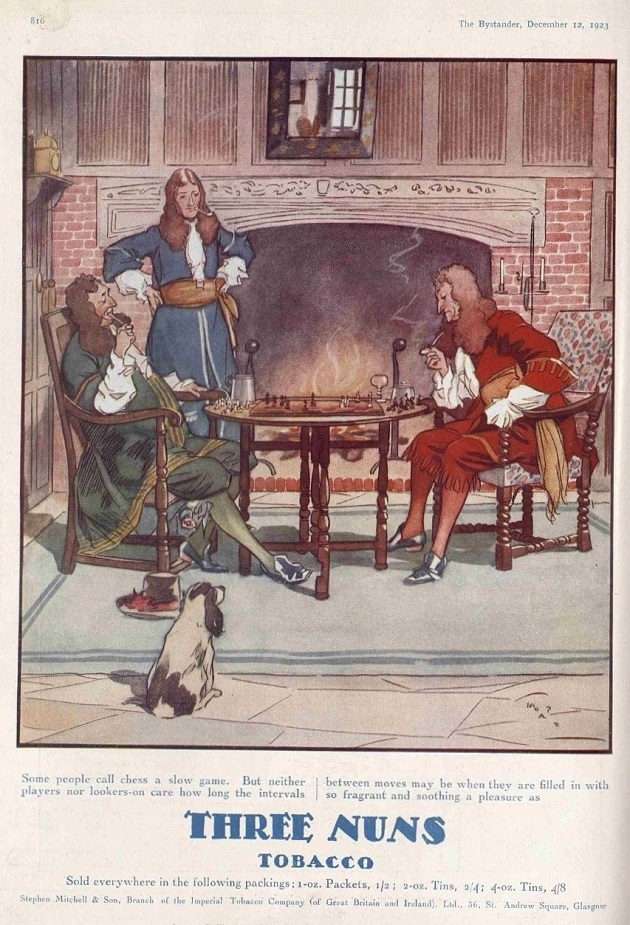
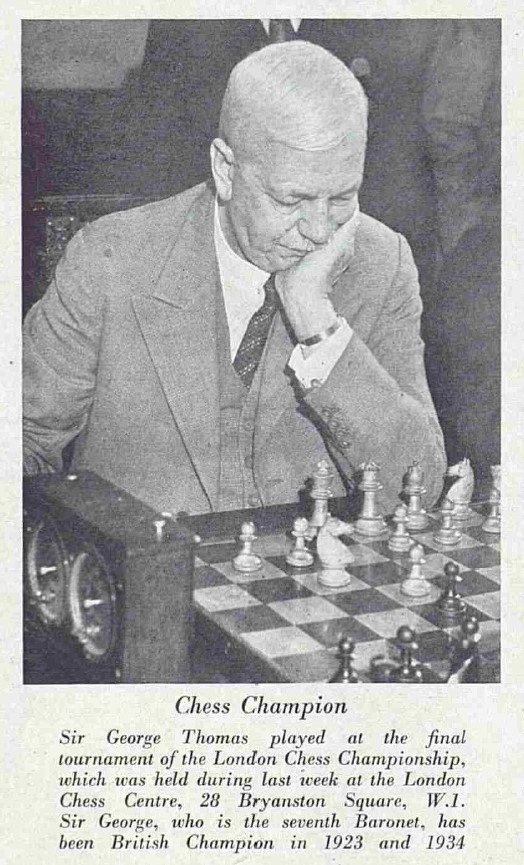
The Tatler and Bystander, 24 October 1945, page 98.
10369. Photographs by G.B. Wood
Eduardo Bauzá Mercére (New York, NY, USA) asks for information about the photographs mentioned in this item from page 5 of the Philadelphia Times, 29 April 1894:
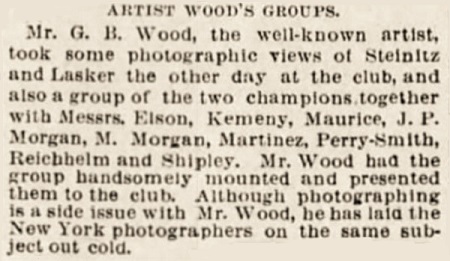
10370. Soldatenkov (C.N. 10365)
John Hilbert (Amherst, NY, USA) provides four cuttings:

Brooklyn Daily Eagle, 13 February 1919, page 2, Section 1
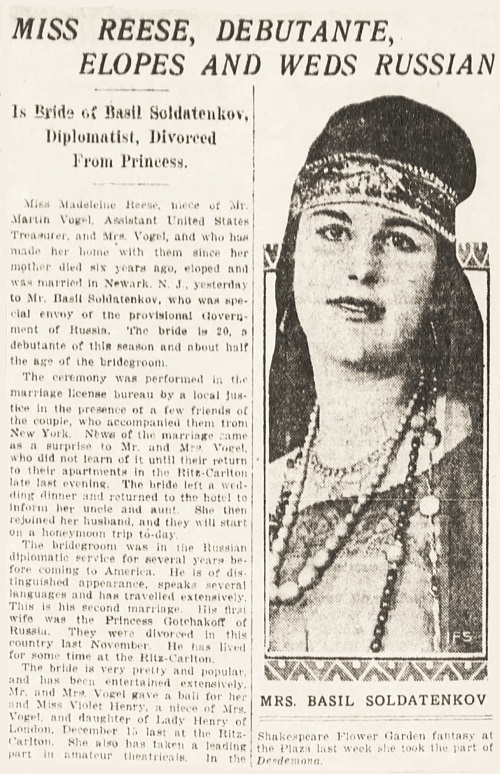
New York Herald, 17 March 1920, page 11
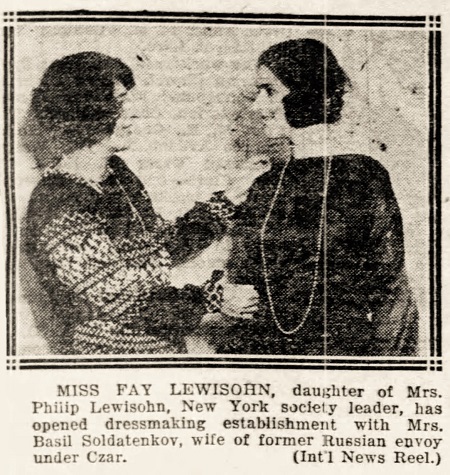
Courier-News (Bridgewater, New Jersey), 12 October 1922
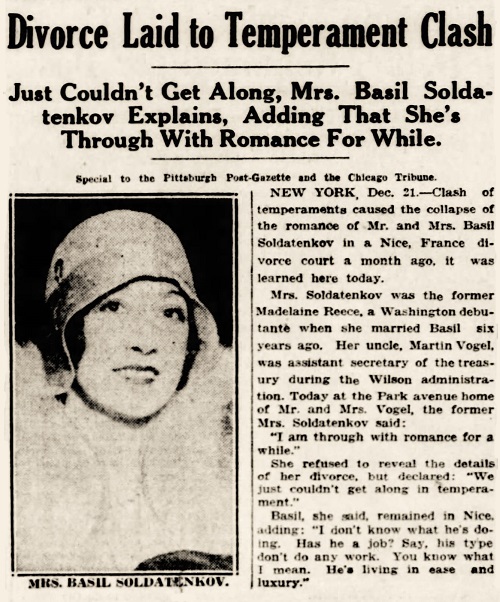
Pittsburgh Post-Gazette, 22 December 1928, page 1.
10371. Smyslov v Botvinnik, Moscow, 1944
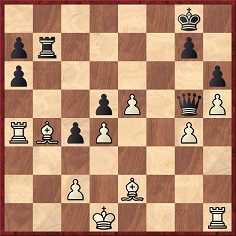
Black to move
In this position from the game between Smyslov and Botvinnik in the 1944 USSR championship in Moscow, Botvinnik played 35...a5, and White resigned at move 41.
In his annotations on pages 16-17 of Chess Review, June-July 1944 Reuben Fine gave 35...a5 an exclamation mark, but on page 2 of the August-September 1944 issue Philip Bromberg of New York pointed out a mate in seven with 35...c3:
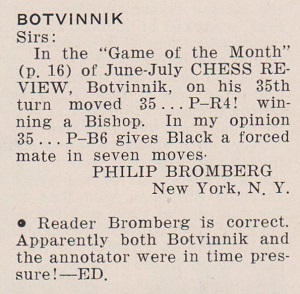
Fine gave due credit to Bromberg on page 109 of Chess Marches On! (New York, 1945), and Bromberg was even acknowledged for the discovery on page 403 of the first ‘Chess Stars’ volume on Botvinnik (Sofia, 2000). Not all writers have shown care, and on page 144 of Mikhail Botvinnik (Jefferson, 2014) Andrew Soltis awarded an exclamation mark to 35...a5.
Earlier monographs such as Partidas selectas de Botwinnik by M. Czerniak (Buenos Aires, 1946) and Botwinnik lehrt Schach by H. Müller (Berlin-Frohnau, 1967) noted the missed mate (see pages 252 and 95 respectively), as did F. Reinfeld on page 209 of Botvinnik the Invincible (Philadelphia, 1946):
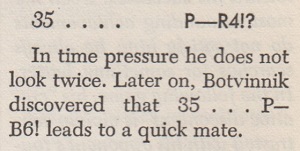
Notwithstanding Reinfeld’s remark, in the two sets of annotations by Botvinnik that we have seen there was no specifically critical comment about 35...a5:

Избранные партии 1926-1946 (Moscow, 1951), page 246

Аналитические и критические работы 1942-1956 (Moscow, 1985), page 54
In the first note Botvinnik stated that 35...c3 was also possible and that there was more than one solution to the problem, and in the second he remarked that there were also other ways to win, such as 35...c3.
From page 3 of the June-July 1944 Chess Review:
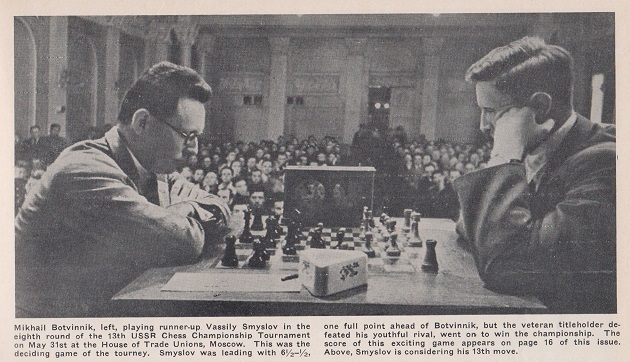
On page 5 Botvinnik contributed an article ‘How I Won The Title’ (‘Via Press Wireless to Chess Review’). After noting Smyslov’s strong start to the tournament, Botvinnik observed:
‘The turning point came in the eighth round when he resigned to me after a stiff battle.’
There was also a paragraph in which Botvinnik described his training for the Soviet championship:
‘For my part, I went to the country with Vyacheslav Ragozin a fortnight before the start. We played quite a few training games with “unknown” results. Our play might have been affected by the radio which was going full blast in the room. We were afraid that the tournament hall might be noisy and decided to accustom ourselves to disturbances. This precautionary measure turned out to be superfluous because the audience behaved well – and Ragozin now insists that the unusual quiet in the hall prevented him from doing better than he did.’
10372. Marianne Allwright
From a report by Elaine Saunders on the 1950 British Girls’ Championship (London, April 1950):
‘The prizes for young competitors were awarded to Jennifer Dawkins, age nine, and Marianne Allwright, age six, both of Comrie House School, Finchley, who this year enlarged their very youthful contingent to seven. Marianne, whose charming childish abandon truly “stole the show” in the eyes of the press, scored two points. It is difficult to refrain from comment upon this chess baby. With some apprehension I watched Marianne climb onto her chair to queen a pawn and then quietly proceed to force the enemy king into a mating net. Although many of her moves were far from good and made without any deep consideration, the child possesses a commendably quick sight of the board.’
Source: BCM, May 1950, page 152.
Examples of the interest shown by the press:
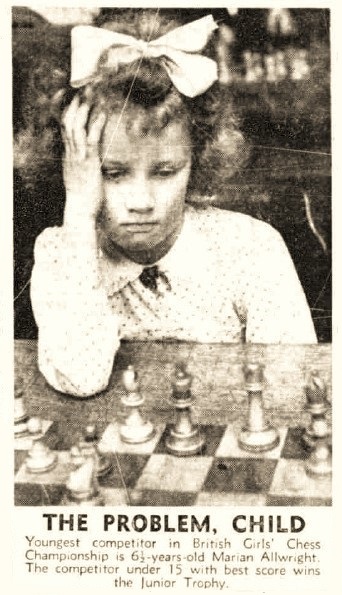
Lincolnshire Echo, 13 April 1950, page 1
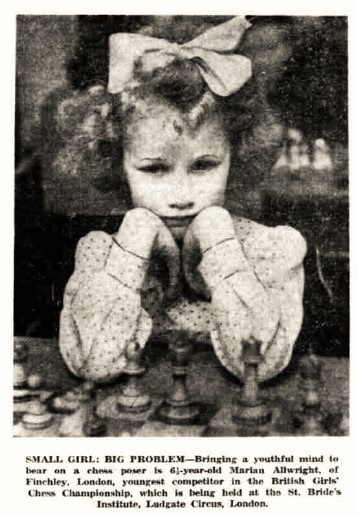
Belfast News-Letter, 14 April 1950, page 8
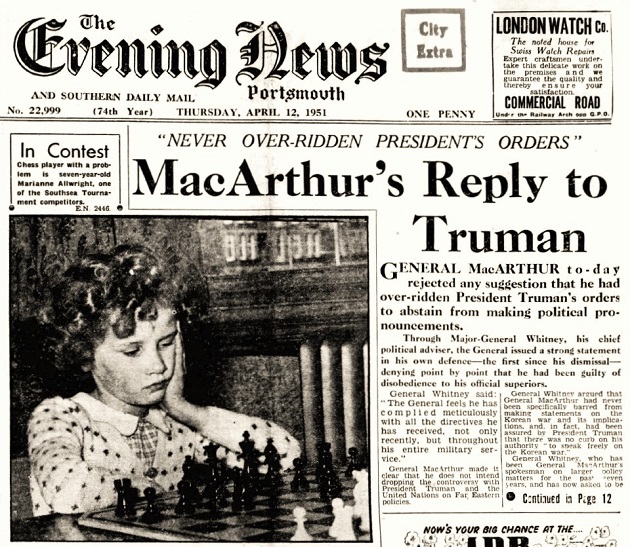
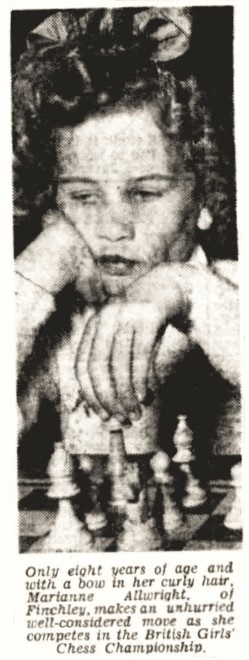
Northern Daily Mail, 17 April 1952, page 3
Marianne Allwright was also featured on page 154 of the May 1950 Chess Review:
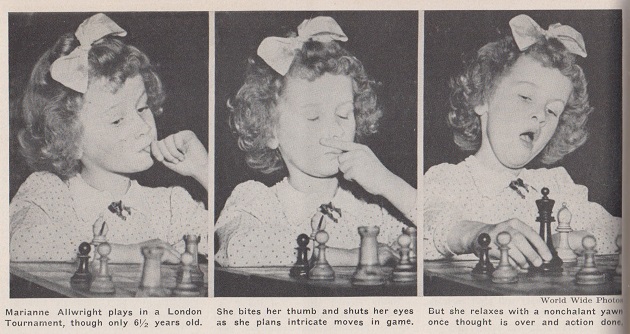
10373. Mate with two knights

Position after 39...d1(N) mate.
That was the conclusion of a game won by Soldatenkov against C.P. Weeks which has been found by Eduardo Bauzá Mercére (New York, NY, USA) in the Brooklyn Daily Eagle, 24 March 1921, Section 1, page 3:
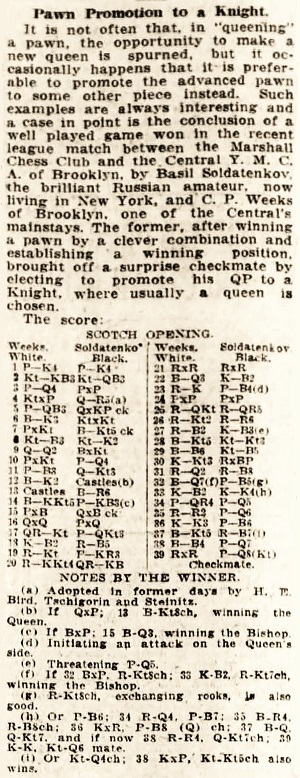
1 e4 e5 2 Nf3 Nc6 3 d4 exd4 4 Nxd4 Qh4 5 c3 Qxe4+ 6 Be3 Nxd4 7 cxd4 Bb4+ 8 Nc3 Ne7 9 Qd2 Bxc3 10 bxc3 d5 11 f3 Qg6 12 Be2 O-O 13 O-O Bh3 14 Bg5 f6 15 gxh3 Qxg5+ 16 Qxg5 fxg5 17 Rab1 b6 18 Kf2 Rf4 19 Rg1 h6 20 Rg4 Raf8 21 Rxf4 Rxf4 22 Bd3 Kf7 23 Re1 c5 24 dxc5 bxc5 25 Rb1 Ra4 26 Rb2 Ra3 27 Rc2 Kf6 28 Bb5 Ng6 29 Bc6 Nf4 30 Kg3 Rxc3 31 Rd2 Rc1 32 Bd7 c4 33 Kf2 Ke5 34 a4 d4 35 Ra2 d3 36 Ke3 c3 37 Bb5 Rc2 38 Bc4

38...d2 39 Rxc2 d1(N) mate.
10374. Mährisch-Ostrau, 1933
Jan Kalendovský (Brno, Czech Republic) reports that he owns this photograph:
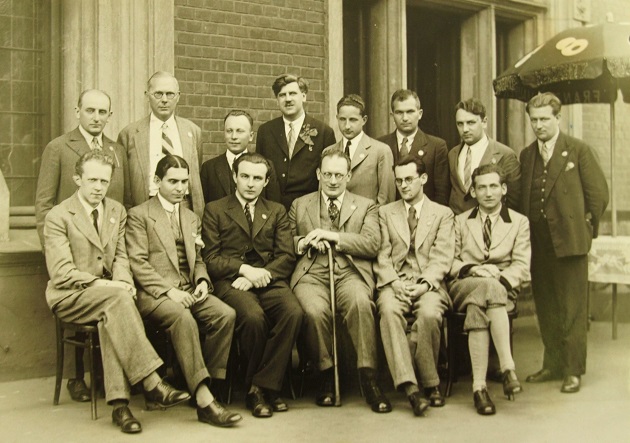

Below we add the captioned photograph from the tournament book, Internationales Schachmeisterturnier Mähr.-Ostrau 1933 by Hans Kmoch and Walther Michalitschke (Mährisch-Ostrau, 1933):

The following page showed the co-authors:

10375. Ilmar Raud (C.N.s 4905, 4944 & 10062)
Juan Sebastián Morgado (Buenos Aires) draws attention to an article ‘El caso Raud’ (part one; part two) which he has contributed to ChessBase.
10376. ‘One of the finest combinations ever played’ (C.N.s 8976 & 8992)
The position was also published on page 9 of Chess Techniques by A.R.B. Thomas (London, 1975):
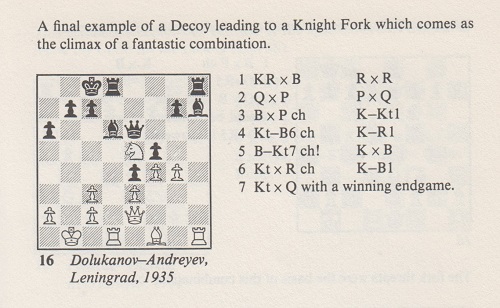
The players’ colours were reversed, for the reason given by Thomas in his Introduction (page ix) and quoted in C.N. 8977.
10377. Roberto the Robot
On the front cover of the July 1959 Chess Review:
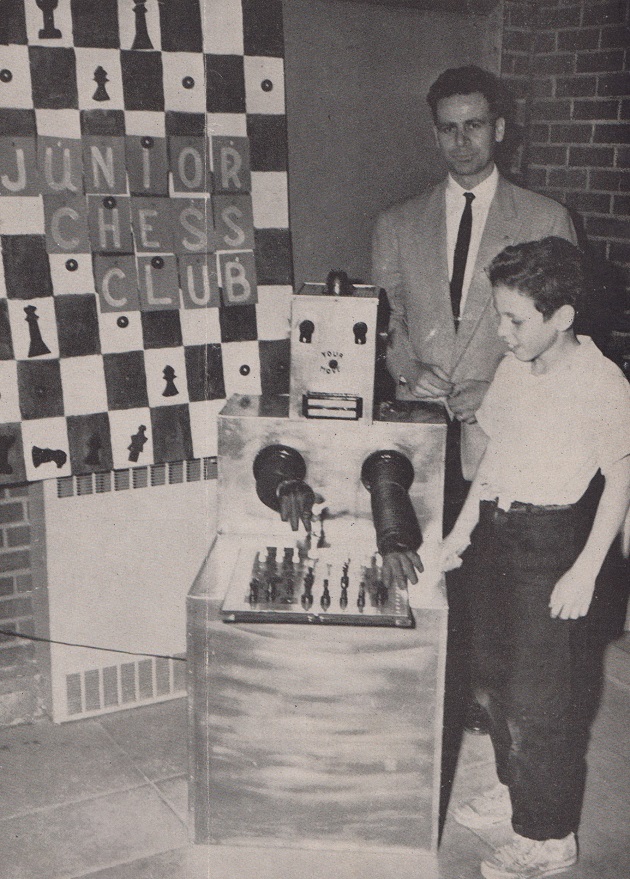
From page 199 of the same issue:
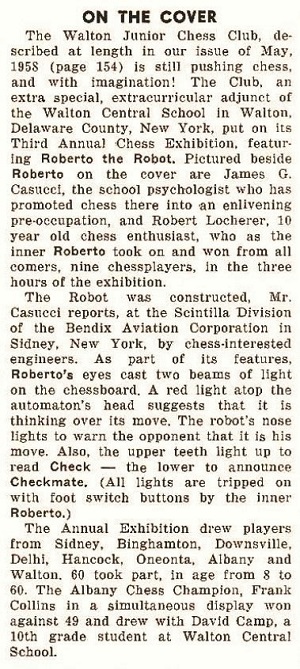
10378. Chess Openings Theory and Practice
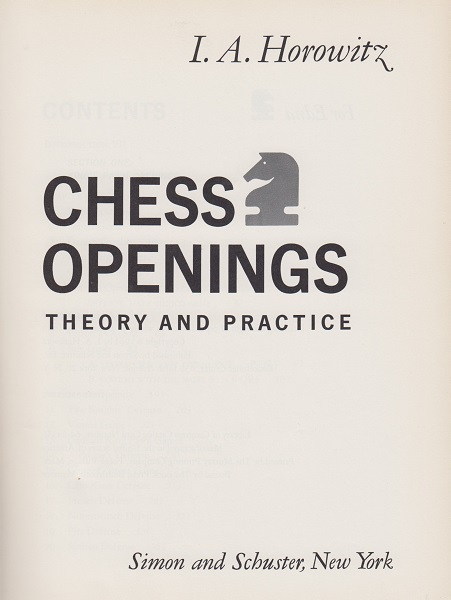
In the light of the references to Horowitz in The Horowitz-Wellmuth Affair and Chess and Ghostwriting, Sean Robinson (Tacoma, WA, USA) asks what is known about the exact genesis of the 789-page volume Chess Openings Theory and Practice by I.A. Horowitz (New York, 1964).
General background information from page viii:
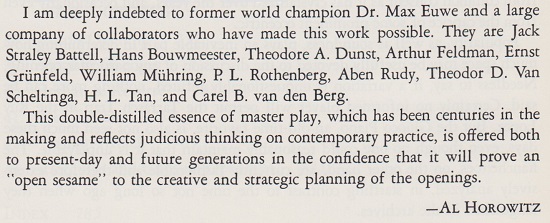
Horowitz’s signature in one of our copies of Chess Openings Theory and Practice:
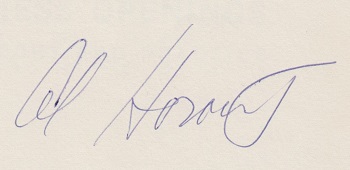
10379. E.A. Michell and R.P. Michell
Ivor Goodman (Stevenage, England) points out webpages with information about Edward Algernon Michell and Reginald Pryce Michell.
10380. Monosson v Fauque (C.N. 7921)
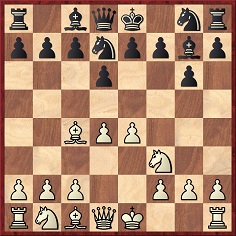
White to move
Han Bükülmez (Ecublens, Switzerland) notes a game between Englund and Smith, Hanover Hauptturnier A, 31 July 1902, in which White played not 5 Bxf7+ but 5 Ng5: 1 e4 g6 2 d4 Bg7 3 Nf3 d6 4 Bc4 Nd7 5 Ng5 e6 6 O-O Ne7 7 Bxe6 O-O 8 Bb3 Nc6 9 c3 h6 10 Nf3 Re8 11 Nfd2 Na5 12 Bc2 c5 13 f4 cxd4 14 Nf3 dxc3 15 Nxc3 Nf6 16 Be3 Ng4 17 Bd4 Nc4 18 Nd5 Be6 19 h3 Bxd5 20 hxg4 Bxe4 21 Bxg7 Ne3 22 Qd4 Nxc2 23 Qc3 Rc8 24 White resigns.
We give the game as published on pages 154-155 of the tournament book:
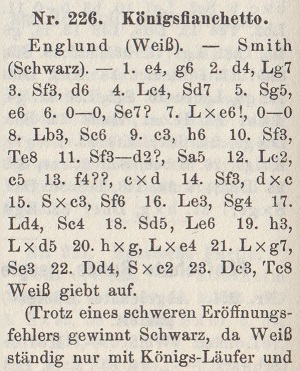

Databases identify Black as Stephen Francis Smith. The crosstable on page xxxiii of the tournament book had ‘D. S. Smith – London’, while ‘D. Smith (London)’ was on page 259 of the August 1902 Deutsche Schachzeitung. Confusion may have arisen over D./Doctor.
10381. Fischer v Grant
From page 3B of Florida Today, 26 May 1975:

Page 37 of the February 1964 Chess Review mentioned ‘Greg Grant, 16-year-old senior at Jamesvill-De Witt [sic] High’.
The game against Grant was Fischer’s only defeat in a large simultaneous display (the overall result of which is debatable) in Rochester, NY on 15 February 1964. It was published on page 13 of A Legend On The Road by John Donaldson (Seattle, 1994) and on pages 20-21 of the second edition (Milford, 2005). The source of the game-score was ‘Robert Nasiff’s monograph on Syracuse chess history’, and Fischer’s 20th and 30th moves received double question marks.
1 e4 e6 2 d4 d5 3 Nc3 Nf6 4 Bg5 dxe4 5 Nxe4 Be7 6 Bxf6 Bxf6 7 Nf3 Bd7 8 c3 Bc6 9 Qc2 g6 10 O-O-O Nd7 11 h4 Bxe4 12 Qxe4 c6 13 h5 Qc7 14 g4 O-O-O 15 g5 Be7 16 Bc4 Nb6 17 Bb3 Nd5 18 Rdg1 Qf4+ 19 Qxf4 Nxf4 20 Rg4 Nd3+ 21 Kc2 Nxf2 22 Rgg1 Nxh1 23 Rxh1 Bd6 24 Kd3 c5 25 d5 b5 26 Ke4 c4 27 Bc2 Rhe8 28 hxg6 hxg6 29 Rh7 Re7 30 Nd4 f5+ 31 White resigns.
10382. Purdy on annotating
‘We do not approve of dry, completely objective annotations – this move is correct, this superior, this inferior, etc. An annotator should try rather to enter into the mind of the player, and explain his ideas.’
Source: Chess World, 1 March 1946, page 33.
10383. Capablanca and the Sicilian Defence (C.N. 10344)
The start of Hans Kmoch’s annotations to Capablanca v Yates, Bad Kissingen, 1928 on page 259 of the Wiener Schachzeitung, September 1928:
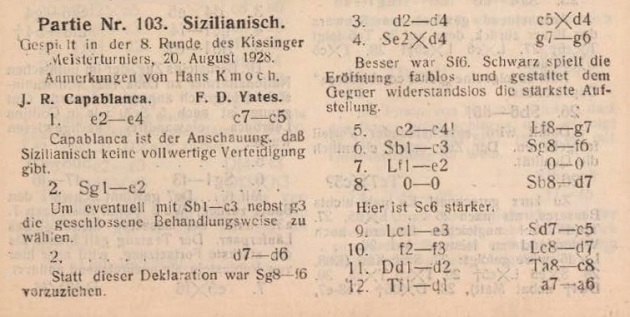
10384. Kmoch and Capablanca
As quoted in Capablanca v Alekhine, 1927, Kmoch’s article ‘My Personal Recollections of Capablanca’ on pages 362-363 of Chess Review, December 1967 included this paragraph (page 362):
‘In Kissingen [1928], my contact with Capablanca became rather close. We had long walks together, usually talking about the world championship in reference to which Capablanca always used the expression “my title”, making it seem that the title had only incidentally and temporarily strayed to Alekhine. More than once he explained to me how I could make a lot of money. Very simple: just organize the return match against Alekhine and bet as much as possible on me; you will win, that much is absolutely sure.’
On page 363 Kmoch wrote:
‘Capablanca used to see incredibly much with but a single glance at the board. There still rings in my ears Réti’s lament: “No sense in showing him a composition because he sees the solution before you have finished setting up the position.”’
10385. Hans Frank
Documentation about Hans Frank and Chess is still sought. From page 3 of the 1 January 1941 issue of Deutsche Schachblätter:
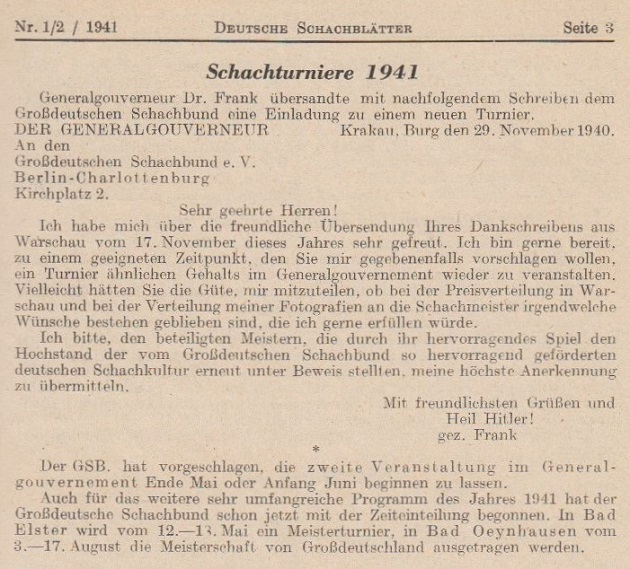
10386. Fischer v Grant (C.N. 10381)
Robert Nasiff (Tully, NY, USA) informs us that his monograph on Syracuse chess history, which was referred to in C.N. 10381, is unpublished and that he had obtained the Fischer v Grant game-score direct from the latter in the second half of the 1960s.
Below, from page 1B of the 16 February 1964 issue of the Democrat and Chronicle (Rochester, NY), we show the report by Earl Caldwell which John Donaldson quoted in A Legend On The Road (first edition: pages 11-12; second edition: pages 18-19):

10387. Spassky v Korchnoi
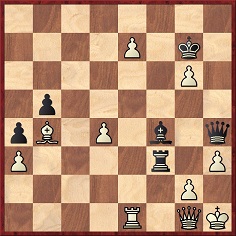
41 Qh2 Resigns
The celebrated move 41 Qh2 was played by Spassky against Korchnoi in the 22nd USSR championship in Moscow, 1955. The full game, with notes by M. Yudovich, was published on page 5 of XXII шахматный чемпионат СССР, 31 March 1955:
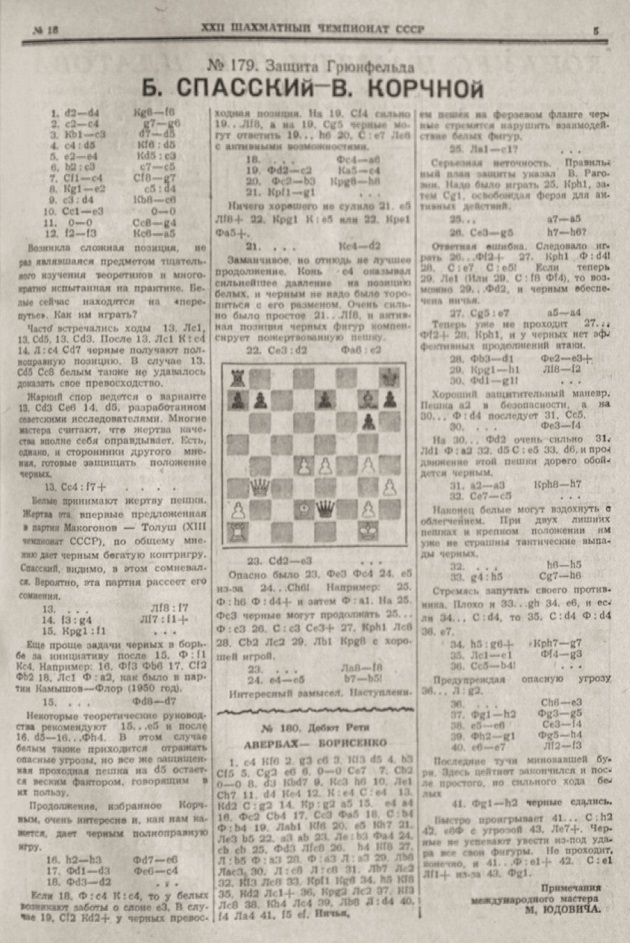
The above scan has been provided by the Cleveland Public Library.
1 d4 Nf6 2 c4 g6 3 Nc3 d5 4 cxd5 Nxd5 5 e4 Nxc3 6 bxc3 c5 7 Bc4 Bg7 8 Ne2 cxd4 9 cxd4 Nc6 10 Be3 O-O 11 O-O Bg4 12 f3 Na5 13 Bxf7+ Rxf7 14 fxg4 Rxf1+ 15 Kxf1 Qd7 16 h3 Qe6 17 Qd3 Qc4 18 Qd2 Qa6 19 Qc2 Nc4 20 Qb3 Kh8 21 Kg1 Nd2 22 Bxd2 Qxe2 23 Be3 Rf8 24 e5 b5 25 Rc1 a5 26 Bg5 h6 27 Bxe7 a4 28 Qd1 Qe3+ 29 Kh1 Rf2 30 Qg1 Qf4 31 a3 Kh7 32 Bc5 h5 33 gxh5 Bh6 34 hxg6+ Kg7 35 Re1 Qg3 36 Bb4 Be3 37 Qh2 Qg5 38 e6 Bf4 39 Qg1 Qh4 40 e7 Rf3 41 Qh2 Resigns.
Some databases give a different move-order in the opening, and a number of publications have discrepancies over the conclusion. Ten moves were lopped off in the Wildhagen volume of Spassky’s games (the ‘big red book’ – see C.N. 8962):
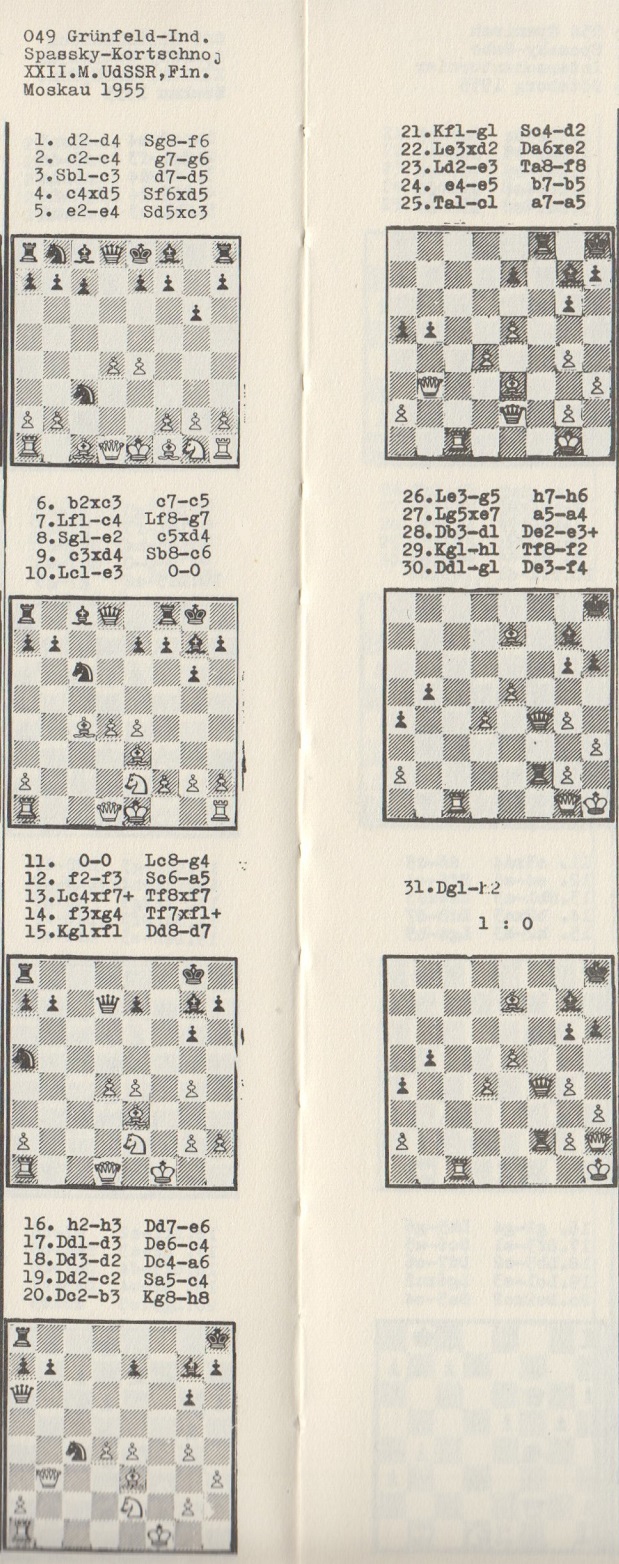
Page 76 of the Encyclopaedia of Chess Middlegames (Belgrade, 1980) had this position (black king on h7, not g7, and no white pawn on g6) before 41 Qh2:

There were black pawns on h7, g6 and f5 in the ‘Winning Practice from the Masters’ article on page 23 of CHESS, 29 October 1955:
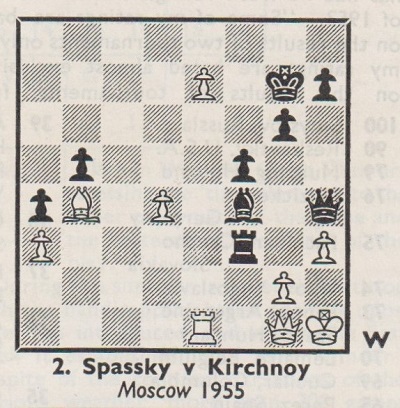
The solution on page 33:
‘1 Q-R2! This seems the only way to nullify complefely [sic] the threat of RxRPch; but now White’s passed pawn wins the game.’
Unaware that the diagram was faulty, CHESS, 12 November 1955, page 41 reported:
‘Some 30 readers point out that in No. 2 of our Winning Practice positions last issue, Korchnoy could have upset Spassky by 1...QxRch 3 [sic] Q-Kt1 RxQch 4 [sic] KxR K-B2 winning the dangerous pawn.
Sir G.A. Thomas, whose card was the first to arrive, points out that by 1 R-K2 White can draw.’
10388. Le Havre, 1966
Guy Gignac (Donnacona, Canada) owns this photograph, taken during the international chess festival in Le Havre, April 1966:
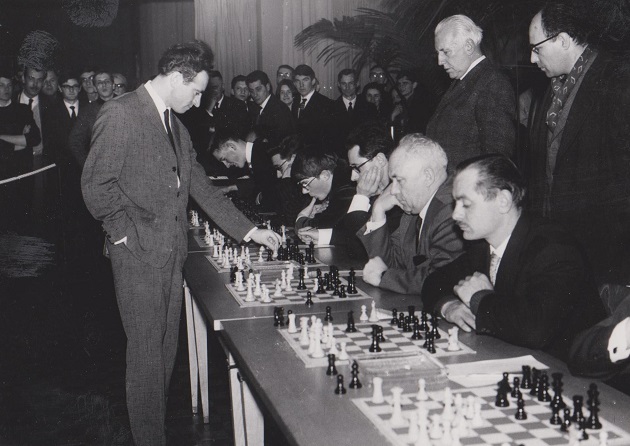
Lev Polugayevsky (above) finished equal second with Krogius in the main tournament, two points behind Larsen.
Beyond France, the festival received relatively little attention in chess magazines of the time, apart from Brian Reilly’s coverage on pages 131-138 of the May 1966 BCM. From page 134:
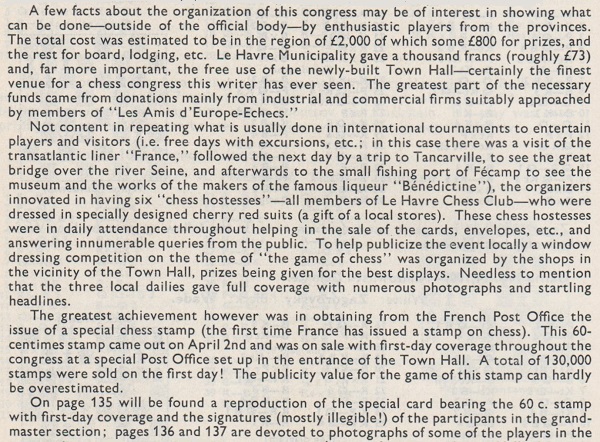
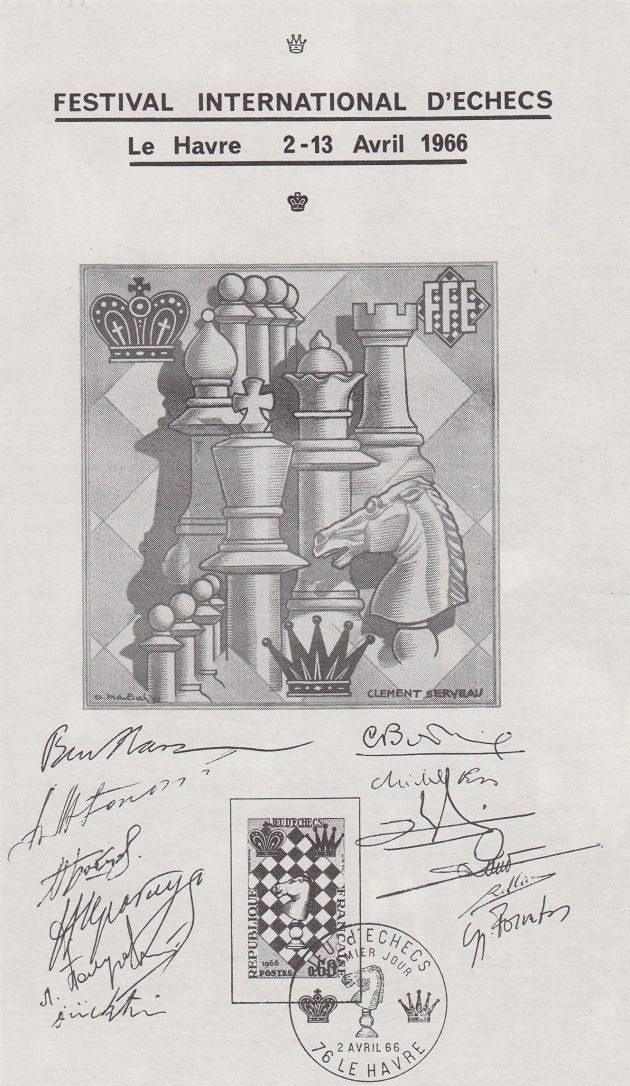
Having referred to the BCM report, Herbert A. Friedman wrote on page 273 of the September 1966 Chess Review:
‘Even today, it is still possible to build up a complete collection of every chess stamp ever issued for well under $100.’
10389. Kasparov
This block of nine postage stamps (North
Korea/‘Democratic People’s Republic of Korea’, with the
dates 1984, 1985 and 1986) is a curiosity in our
collection:
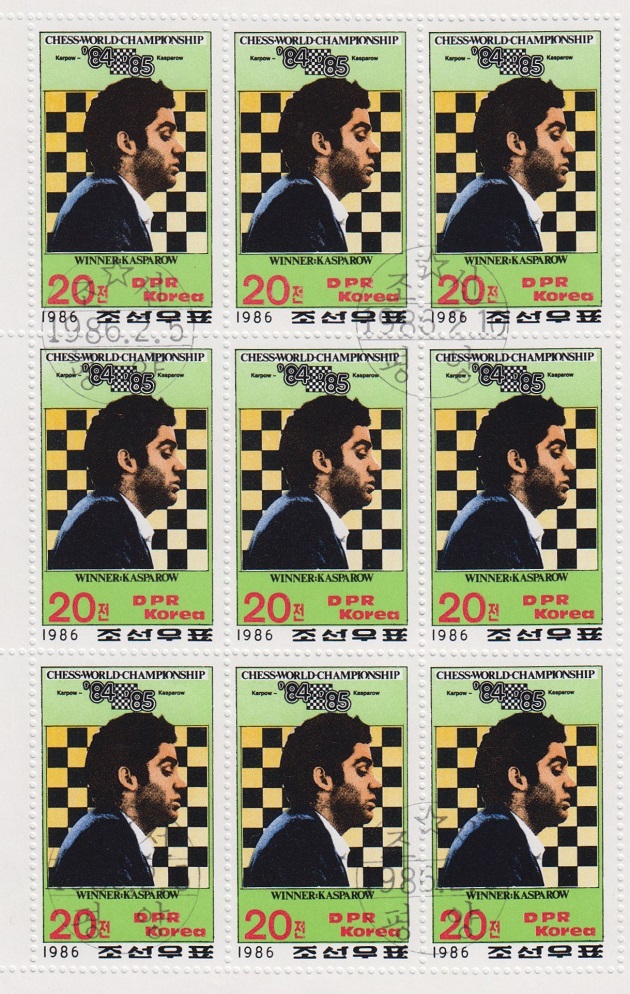
10390. Schack i Sverige
Just received: Schack i Sverige (subtitle: Sveriges Schackförbund 100 år 1917-2017) by Lasse Linusson and Peter Holmgren (Norrköping, 2017), a large-format 496-page hardback available from the Swedish Chess Federation.
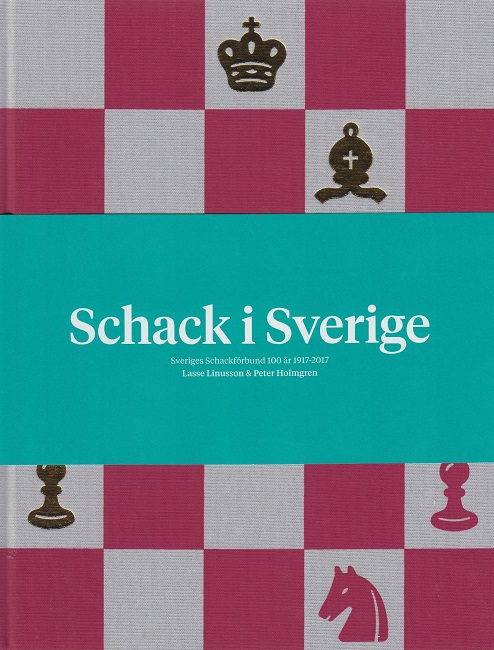
10391. Bismarck Speaks
The frontispiece of the final (December 1899) issue of the American Chess Magazine:
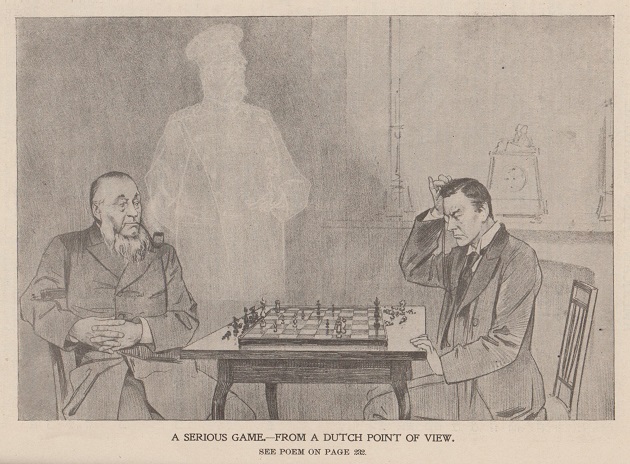
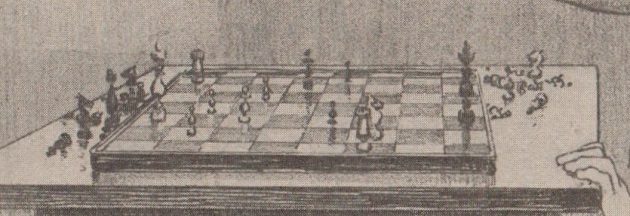
The poem by Jocelyn Johnstone on page 232:
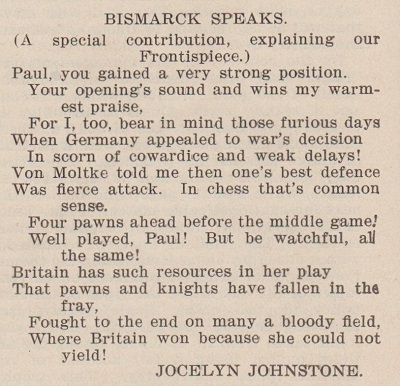
In the cartoon, which concerned the Boer War, the late Otto von Bismarck is standing, and the chess game is between Paul Kruger (the President of the South African Republic) and Joseph Chamberlain (the British Secretary of State for the Colonies).
10392. Edward George Spencer-Churchill (1876-1964)
The reference to the Boer War in the previous item reminds us of a paragraph on page 195 of the Deutsche Schachzeitung, June 1900:

Edward George Spencer-Churchill represented Oxford University in four successive Varsity matches, as reported on pages 68-69 of The Book of Blues edited by Ogier Rysden (London, 1900):
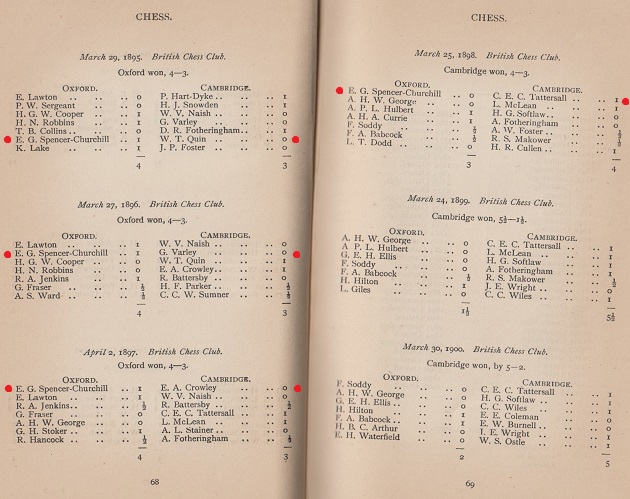
The 1895 game against W.T. Quin was published on pages 275-276 of the Chess Monthly, May 1895 and, as shown below, on page 7 of the Standard, 2 April 1895:
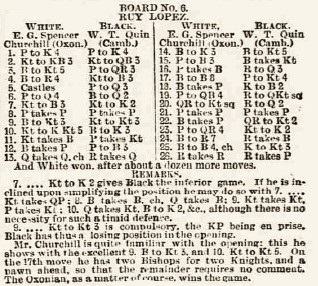
1 e4 e5 2 Nf3 Nc6 3 Bb5 a6 4 Ba4 Nf6 5 O-O d6 6 d4 Bd7 7 Nc3 Ne7 8 dxe5 dxe5 9 Bb3 Ng6 10 Ng5 Be6 11 Nxe6 fxe6 12 Bxe6 c6 13 Qxd8+ Rxd8 14 Be3 Bb4 15 f3 Bxc3 16 bxc3 Rd6 17 Bc8 b5 18 Bxa6 Kf7 19 c4 Rb8 20 Rab1 Rd7 21 cxb5 cxb5 22 Bxb5 Rdb7 23 a4 Ne7 24 Ba7 Rxa7 25 Bc4+ Kg6 26 Rxb8 Rxa4. The remaining moves from the Chess Monthly: 27 Bd3 Rd4 28 Rb6 Kf7 29 Rfb1 Nd7 30 R6b4 Rd6 31 Bc4+ Kf6 32 Be2 Ng6 33 Rd1 Ke7 34 Rxd6 Kxd6 35 Bc4 Kc5 36 Rb7 Nf6 37 Bd5 Nh5 38 c4 Resigns.
Spencer-Churchill’s 1896 game against G. Varley was discussed on page 197 of the May 1896 BCM:
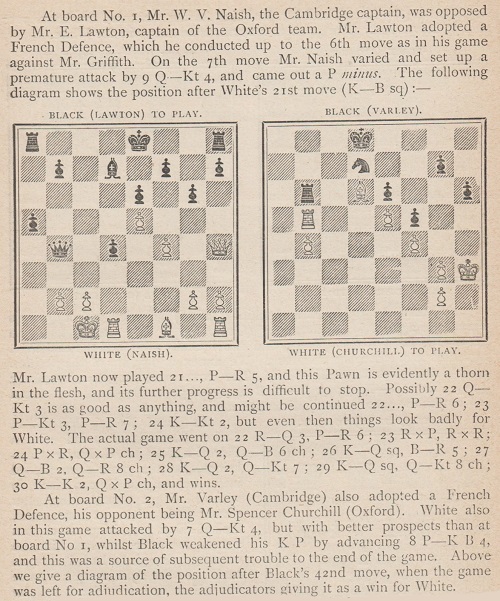
Part of the game against Aleister Crowley (1875-1947) was given on page 180 of the May 1897 BCM. The full score was published in the Morning Post, 3 April 1897, page 5, and the Illustrated Sporting and Dramatic News, 10 April 1897, page 236:

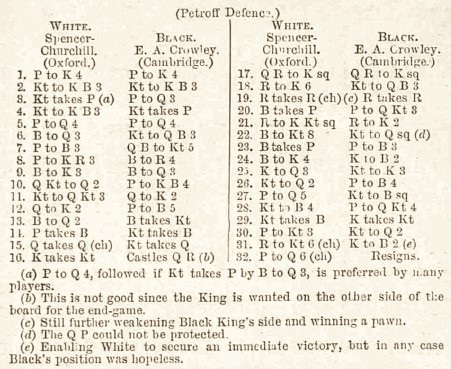
1 e4 e5 2 Nf3 Nf6 3 Nxe5 d6 4 Nf3 Nxe4 5 d4 d5 6 Bd3 Nc6 7 c3 Bg4 8 h3 Bh5 9 Be3 Bd6 10 Nbd2 f5 11 Nb3 Qe7 12 Qe2 f4 13 Bd2 Bxf3 14 gxf3 Nxd2 15 Qxe7+ Nxe7 16 Kxd2 O-O-O 17 Rae1 Rde8 18 Re6 Nc6 19 Rxe8+ Rxe8 20 Bxh7 b6 21 Rg1 Re7 22 Bg8 Nd8 23 Bxd5 c6 24 Be4 Kc7 25 Kd3 Ne6 26 Nd2 c5 27 d5 Nf8 28 Nc4 b5 29 Nxd6 Kxd6 30 b3 Nd7 31 Rg6+ Kc7 32 d6+ Resigns.
A further, slightly later, source for the game is the Westminster Budget, 16 April 1897, page 28.
Spencer-Churchill’s defeat by C.E.C. Tattersall was published on page 24 of the Westminster Budget, 1 April 1898:
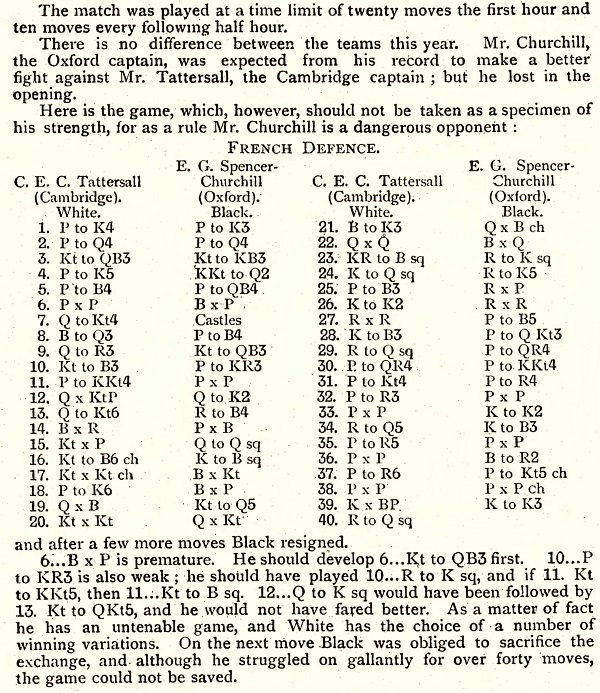
1 e4 e6 2 d4 d5 3 Nc3 Nf6 4 e5 Nfd7 5 f4 c5 6 dxc5 Bxc5 7 Qg4 O-O 8 Bd3 f5 9 Qh3 Nc6 10 Nf3 h6 11 g4 fxg4 12 Qxg4 Qe7 13 Qg6 Rf5 14 Bxf5 exf5 15 Nxd5 Qd8 16 Nf6+ Kf8 17 Nxd7+ Bxd7 18 e6 Bxe6 19 Qxe6 Nd4 20 Nxd4 Qxd4 21 Be3 Qxe3+ 22 Qxe3 Bxe3 23 Rf1 Re8 24 Kd1 Re4 25 c3 Rxf4 26 Ke2 Rxf1 27 Rxf1 f4 28 Kf3 b6 29 Rd1 a5 30 a4 g5 31 b4 h5 32 h3 axb4 33 cxb4 Ke7 34 Rd5 Kf6 35 a5 bxa5 36 bxa5 Ba7 37 a6 g4+ 38 hxg4 hxg4+ 39 Kxf4 Ke6 40 Rd1 ‘and after a few more moves Black resigned’.
Other games played by Spencer-Churchill at Oxford University include a draw against A. Hirsch and a victory over E.R. Turner (mentioned on pages 229-230 of the April 1896 Chess Monthly).
On page 16 of A Century of British Chess (London, 1934) P.W. Sergeant wrote:
‘As Oxford president, and therefore selector of the team against Cambridge, I did two other things which I remember with some feeling of wonder. I persuaded E.G. Spencer-Churchill, of Magdalen, against the advice of his tutors, that he must play chess for Oxford ...’
A curiosity regarding Spencer-Churchill is this cutting from the Times-Democrat (New Orleans), 22 April 1900, page 8, which reproduced a report from the Newcastle Weekly Courant that he had received lessons from Emanuel Lasker:
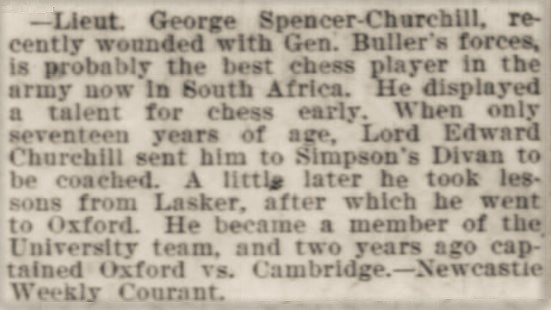
Later references to Spencer-Churchill and chess are scarce, but page 10 of the Times, 22 August 1922 related a social occasion in connection with the London tournament:
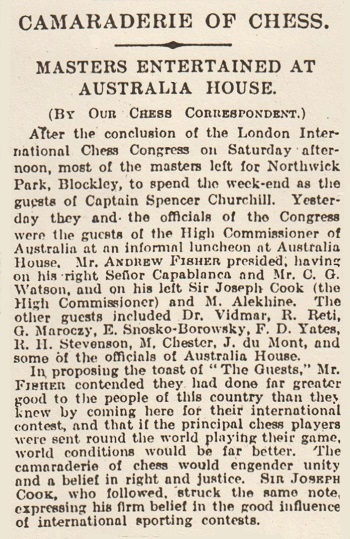
The same newspaper (23 October 1922 edition, page 7) recorded that at a 33-board simultaneous exhibition given by Capablanca against the Maccabean Society at the Hotel Cecil in London the previous day, E.G. Spencer-Churchill was one of four players who drew.
His obituary on page 12 of the Times, 25 June 1964:
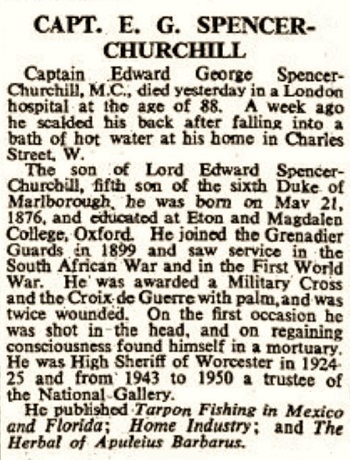
10393. Planning
Further to our new feature article, Chess Planning, below is a remark by Reuben Fine on page 34 of Chess Marches On! (New York, 1945), in his annotations to the game between J. Moskowitz (‘Moscowitz’) and A. Yanofsky, Ventnor City, 1942:
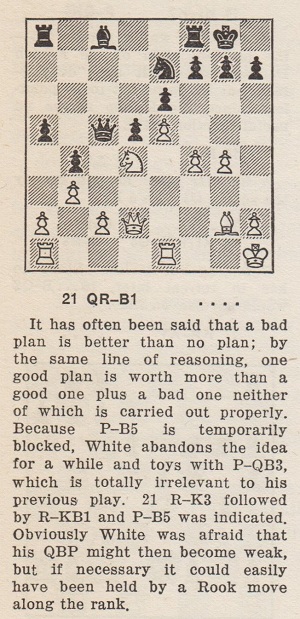
Another passage written by Reuben Fine comes from page 11 of the January 1956 issue of Chess Review:
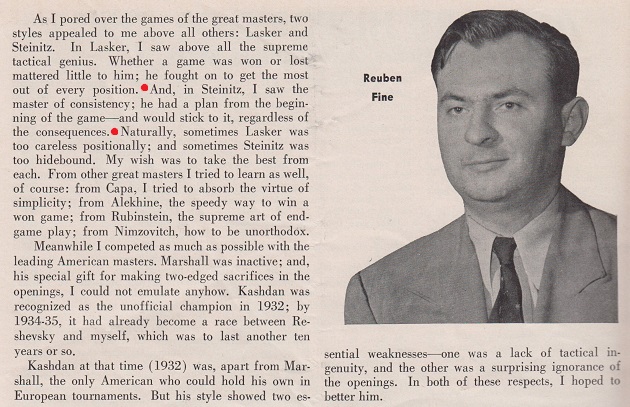
The full article was reproduced on pages 18-23 of Fine’s book Lessons from My Games (New York, 1958).
10394. Letters written by Alexander McDonnell
The feature article on Alexander McDonnell refers to an 1834 letter of his published on pages 250-251 of the Chess Player’s Chronicle, 1846. The full text:

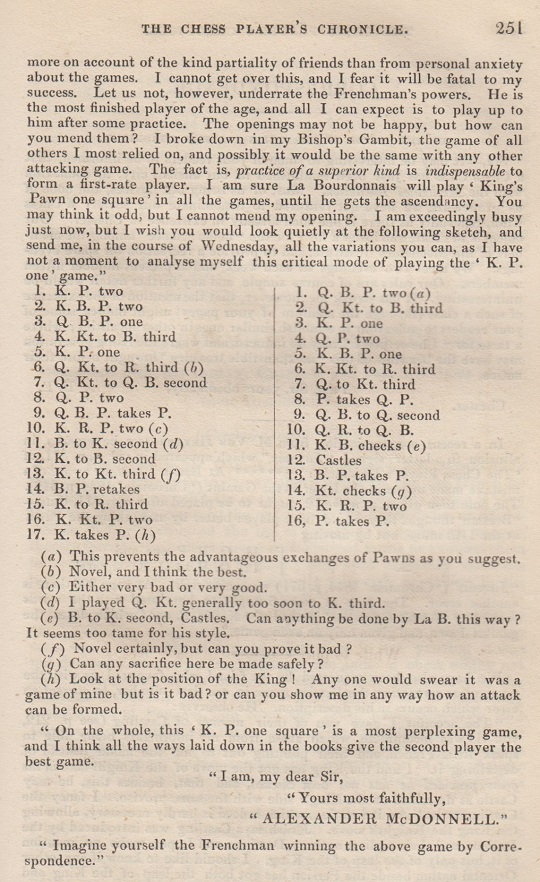
The moves discussed: 1 e4 c5 2 f4 Nc6 3 c3 e6 4 Nf3 d5 5 e5 f6 6 Na3 Nh6 7 Nc2 Qb6 8 d4 cxd4 9 cxd4 Bd7 10 h4 Rc8 11 Be2 Bb4+ 12 Kf2 O-O 13 Kg3 fxe5 14 fxe5 Nf5+ 15 Kh3 h5 16 g4 hxg4+ 17 Kxg4.
Page 245 of Amusements in Chess by Charles Tomlinson (London, 1845) stated that the recipient of the letter was ‘Mr Walker’.
Another letter, written by McDonnell on 7 July 1834, was quoted on page 40 of the Westminster Papers, 2 July 1877, and more details are sought:
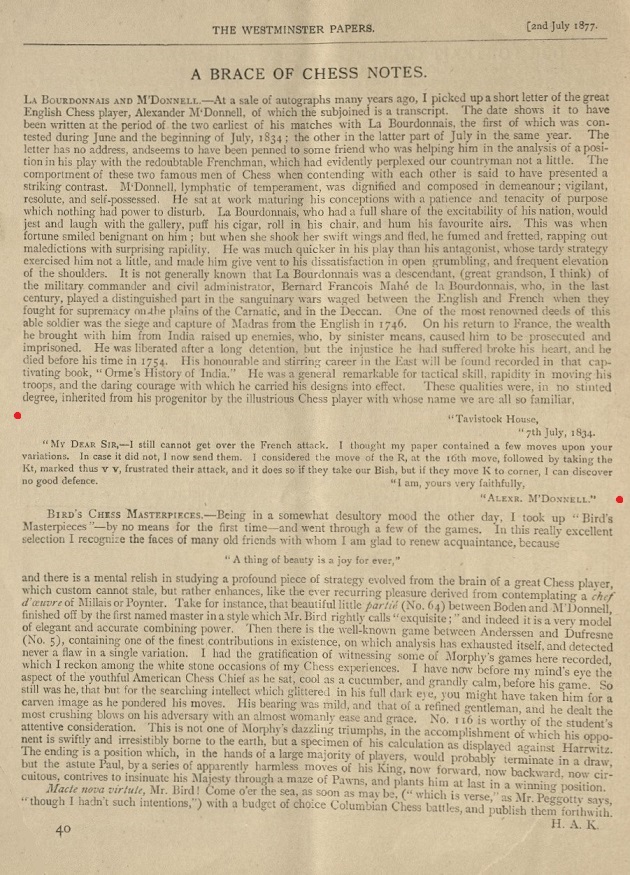
10395. An interview with Blackburne
Olimpiu G. Urcan (Singapore) sends an interview with J.H. Blackburne published on page 6 of the Derbyshire Advertiser and Journal, 2 December 1887:

The newspaper then gave a detailed report, without games, of Blackburne’s 28-board simultaneous display in Derby the previous week (24 November 1887).
10396. Emanuel Lasker in Hamburg
Four games played by Lasker in simultaneous displays have been provided by Thomas Niessen (Aachen, Germany):
Fles – Emanuel Lasker
Hamburg, 4 September 1896
Queen’s Gambit Declined
1 d4 d5 2 c4 e6 3 Nc3 Nf6 4 Nf3 c5 5 Bg5 cxd4 6 Bxf6 gxf6 7 Nxd4 dxc4 8 e3 Rg8 9 Qc2 e5 10 Ndb5 Be6 11 Qa4 Nc6 12 Rd1 Qb6 13 Bxc4
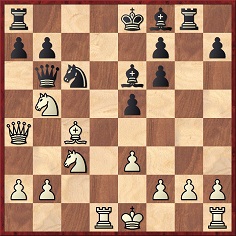
13...Rxg2 14 Bxe6 fxe6 15 Qc4 Rd8 16 Qxe6+ Be7 17 Nd6+ Rxd6 18 Rxd6 Qxb2 19 Nd1 Qb4+ 20 Rd2 Rg6 21 Nb2 Qe4 22 Rf1 f5 23 Qd7+ Kf8 24 Kd1 f4 25 Qd3 Qb4 26 Qf5+ Kg7 27 Nd3 Qa4+ 28 Rc2 Rd6 29 Rg1+ Kh8 30 Kc1 Qa3+ 31 Kd2
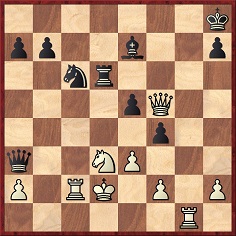
31...Rxd3+ 32 Qxd3 Bb4+ 33 Rc3 Qb2+ 34 Qc2 Bxc3+ and Black won.
Source: Neue Hamburger Zeitung, 20 September 1896, page 10.
Oeltjen – Emanuel Lasker
Hamburg, 4 September 1896
Four Knights’ Game
1 e4 e5 2 Nf3 Nc6 3 Nc3 Nf6 4 Bb5 d6 5 d4 Bd7 6 Bxc6 Bxc6 7 O-O Nxe4 8 Re1 Nxc3 9 bxc3 f6 10 Nh4 g6 11 d5 Bd7 12 f4 Bg7 13 f5 g5 14 Qh5+ Kf8 15 Nf3 Qe8 16 Qh3 h5 17 Nd4
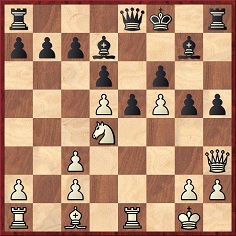
17...exd4 18 Rxe8+ Rxe8 19 cxd4 Re1+ 20 Kf2 Re4 21 Qb3 Bxf5 22 Qxb7 Re7 23 Be3 Kf7 24 Qb3 Rhe8 25 Re1 Be4 26 c4 Kg6 27 Qd1 f5 28 Kf1 h4 29 h3 Bf6 30 Bf2 Rb8 31 Qd2 Ree8 32 Kg1 Rb7 33 Qa5 Reb8 34 a4 Bd8 35 c5 c6 36 Qa6 Bxd5 37 Re8 Rb1+ 38 Be1 R8b2 39 Re2 Bf6 40 cxd6
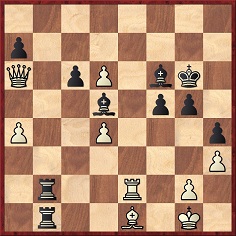
40...Rxe1+ 41 Rxe1 Bxd4+ 42 White resigns.
Source: Neue Hamburger Zeitung, 13 September 1896, page 10.
A report on the above 25-board exhibition from the Hamburger Nachrichten, 6 September 1896 page 4:
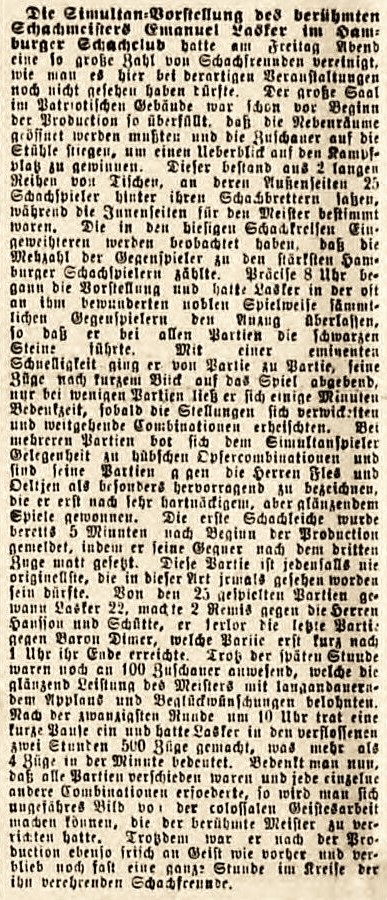
The two games below are from a 31-board display by the world champion:
Emanuel Lasker – Hans Fahrni
Hamburg, 30 January 1904
Caro-Kann Defence
1 e4 c6 2 d4 d5 3 Nc3 Nf6 4 e5 Ng8 5 f4 e6 6 Nf3 Nh6 7 Bd3 c5 8 Be3 Ng4 9 Bg1 c4 10 Bf1 Bb4 11 Nd2 Nh6 12 Ne2 Nc6 13 c3 Ba5 14 b3 b5 15 b4 Bb6 16 a4 bxa4 17 Qxa4 Bd7 18 Qa6 O-O 19 Nf3 Qc7 20 h3 Rfb8 21 g4
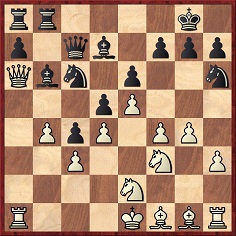
21...Ba5 22 b5 Rb6 23 Rxa5 Rxa6 24 Rxa6 Nd8 25 b6 Qb7 26 Rxa7 Rxa7 27 bxa7 Qxa7 28 Be3 Ba4 29 Ng3 Bc2 30 Bd2 Qa2 31 Be2 Kf8 32 Kf2 Be4 33 Rd1 Bc2 34 Rc1 Nc6 35 f5 Ng8 36 fxe6 fxe6 37 Ng5 Ke7 38 Nh5
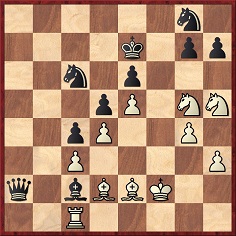
38...h6 39 Nxe6 Kxe6 40 Nf4+ Kf7 41 e6+ Ke7 42 Nxd5+ Kxe6 43 Bxc4 Qxc4 44 Ne3 Qd3 45 d5+ Kf7 46 Rxc2 Na5 47 Ra2 Ne7 48 White resigns.
Sources: Neue Hamburger Zeitung, 6 February 1904, page 18, and Hamburger Nachrichten, 7 February 1904, page 28.
Kaiser – Emanuel Lasker
Hamburg, 30 January 1904
Queen’s Pawn Counter Gambit
1 e4 e5 2 Nf3 d5 3 Nxe5 dxe4 4 d4 exd3 5 Bxd3 Bd6 6 Nc4 Nc6 7 O-O Be6 8 Nxd6+ Qxd6 9 Nc3 Nf6 10 Ne4 Nxe4 11 Bxe4 O-O-O 12 Qxd6 Rxd6 13 Bf4 Rd4 14 f3 f5 15 c3 Rc4 16 Bxc6 Rxf4 17 Bb5 Bd5 18 Rfe1
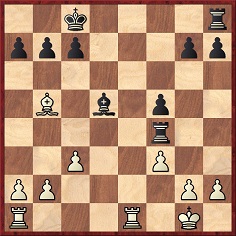
18...g5 19 Re5 c6 20 Bd3 Rf8 21 Rae1 h5 22 Re8+ Rxe8 23 Rxe8+ Kd7 24 Re5 Kd6 25 Rxf5 Rxf5 26 Bxf5 Bxa2 27 h4 gxh4 28 Bg6 Ke5 29 Bxh5
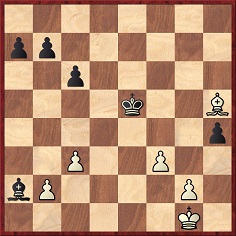
29...Kf4 30 Kf2 a5 31 Bg6 Bc4 32 Be4 Bd5 33 Bc2 b6 34 Bd3 c5 35 Bc2 b5 36 Ke2 Kg3 37 Kf1 c4 38 Kg1 b4 39 cxb4 axb4 40 Kf1 c3 41 bxc3 bxc3 42 Kg1 Ba2 43 Kf1 Bc4+ 44 Kg1 Bb5 45 Kh1 Bf1 46 Kg1 Bxg2 47 f4 h3 48 f5 h2 mate.
Source: Hamburger Nachrichten, 7 February 1904, page 28.
10397. The Immortal Problem
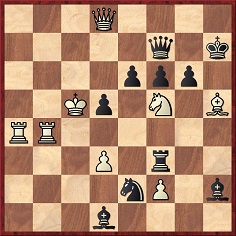
White mates in nine moves
1 Rb7 Qxb7 2 Bxg6+ Kxg6 3 Qg8+ Kxf5 4 Qg4+ Ke5 5 Qh5+ Rf5 6 f4+ Bxf4 7 Qxe2+ Bxe2 8 Re4+ dxe4 9 d4 mate.
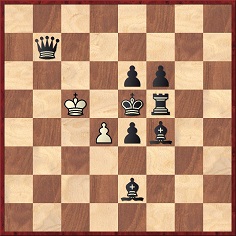
The origins of this ‘Immortal Problem’, composed by Konrad Bayer (1828-97) in the 1850s, are the subject of contradictory information in chess reference books. For example:
- Dictionnaire des échecs (1967), pages 135-136: ‘1er prix Concours de L’Era, 1856’;
- The Encyclopaedia of Chess (1970), pages 219-210: ‘Era, 6 July 1856’;
- Dizionario enciclopedico degli scacchi (1971), page 41: ‘The Era, 1856’ and ‘Secondo Amelung, questo problema fu pubblicato per la prima volta sulla Leipziger Illustrierte Zeitung del 1855, senza nome dell’autore’;
- Lexicon für Schach Freunde (1980), page 326: ‘Leipziger Illustrirte Zeitung (1851), The Era (1856)’;
- The Oxford Companion to Chess (1992), page 33: ‘first published anonymously in the Leipziger Illustrierte Zeitung, 1855’;
- Meyers Schach Lexikon (1993), page 31: ‘Leipziger Illustrierte Zeitung, 1855’.
D.J. Morgan discussed the problem in the BCM (July 1960, page 200 and February 1962, page 53); both items referred to The Era of 6 July 1856, and the second one added ‘Leipziger Illustrirte, 16 August 1851’.
Below, firstly, is the problem’s appearance in The Era, 6 July 1856, page 5 (with, it will be noted, a black pawn on b2):
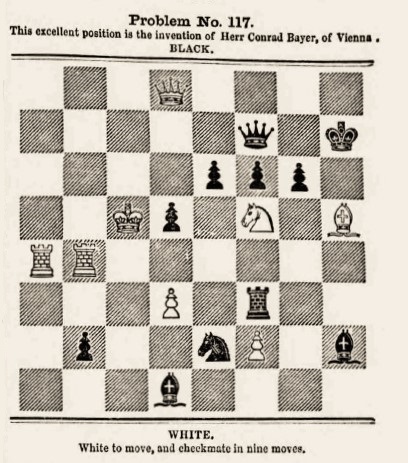
The solution was given on page 13 of the 10 August 1856 edition of The Era. It is unclear why the Dictionnaire des échecs stated that the composition won the Era competition. That contest, won by Bayer, concerned a set of two three-movers, two four-movers and two five-movers (The Era, 6 January 1856, page 13). Bayer and the other winners were announced on page 13 of the newspaper’s 18 January 1857 edition. See too pages 61-63 of the February 1857 Deutsche Schachzeitung. The Cleveland Public Library has confirmed to us that the nine-mover is not included in Löwenthal’s book on the problem tournament (London, 1857).
Notwithstanding the ‘Conrad’ in The Era (also adopted by Jeremy Gaige in Chess Personalia), Konrad Bayer is the established spelling, and C.N. 8269 has a reference to Konrad Bayer’s anagrammatic pseudonym, Drakon Rabey. Konrad Bayer was also the spelling in an article about him on pages 289-291 of the October 1865 Deutsche Schachzeitung which was accompanied by this illustration and signature:
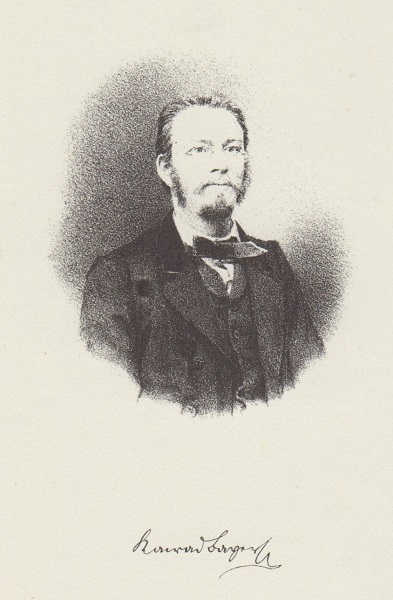
A clearer version of the picture was published on page 258 of CHESS, 14 March 1938:
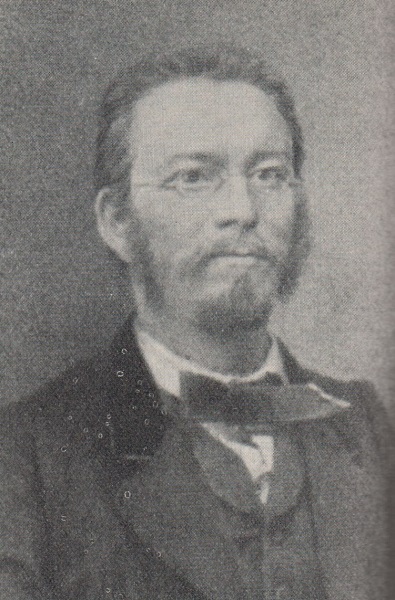
In the above-mentioned BCM item in July 1960 D.J. Morgan commented:
‘The “Immortal Game” was given its title when the claims to immortality were, relatively, few and tenuous. The accompanying position was christened the Immortal Problem and, for several decades, ranked as one of the greatest extant compositions. But its checking pursuit has long ceased to excite, and the problem is largely forgotten.’
The phrase ‘now largely forgotten’ was used a decade later in The Encyclopaedia of Chess. For its part, The Oxford Companion to Chess (second edition) asserted:
‘Considered to be the “last word” in this genre, the problem was immediately dubbed “the Immortal Problem”, and almost as immediately forgotten, for the problem art was fast changing to its modern form.’
The problem was indeed in the old style, but the term ‘forgotten’ cannot be justified.
In presenting the further documentation below we are indebted to one of the chess world’s finest researchers, Peter Anderberg (Harmstorf, Germany), for a number of the German-language items and, especially, for providing the original (1851) publication of the problem:
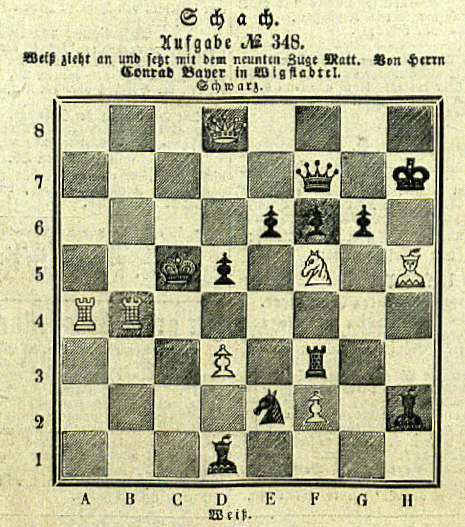
lllustrirte Zeitung 16 August 1851, page 160
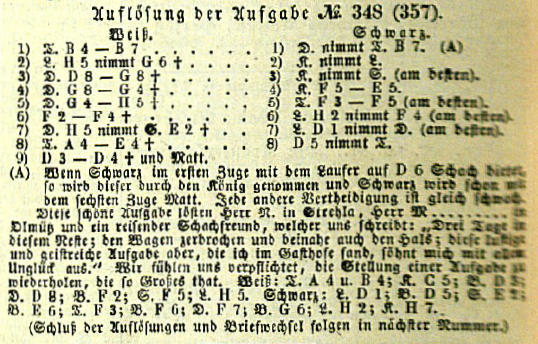
It will be noted that Bayer was identified as the composer.
His problem was the subject of a detailed historical article, ‘Die unsterbliche Aufgabe in neun Zügen’, on pages 298-300 of Heft 7 (1900) of F. Amelung’s Baltische Schachblätter, an article reproduced on pages 66-68 of the March 1900 Wiener Schachzeitung. See too ‘Die sogenannte unsterbliche Aufgabe’ on pages 211-214 of the May-July 1907 Wiener Schachzeitung. As mentioned in C.N. 7728, the Wiener Schachzeitung is available online at the ANNO website.
By way of example, below are further appearances of Bayer’s problem:
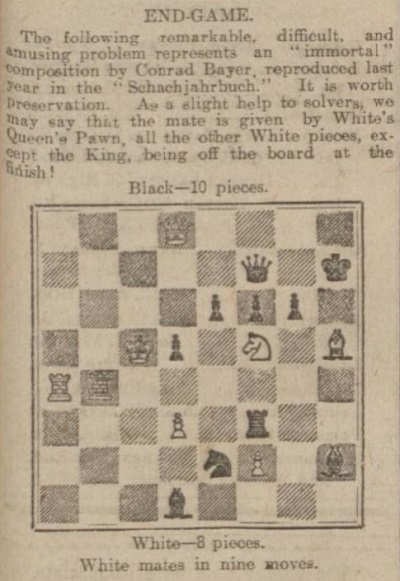
Falkirk Herald, 24 November 1909, page 7
The article in the Anhang zum Schachjahrbuch 1907 by L. Bachmann (Ansbach, 1908) which was mentioned by the Falkirk Herald:
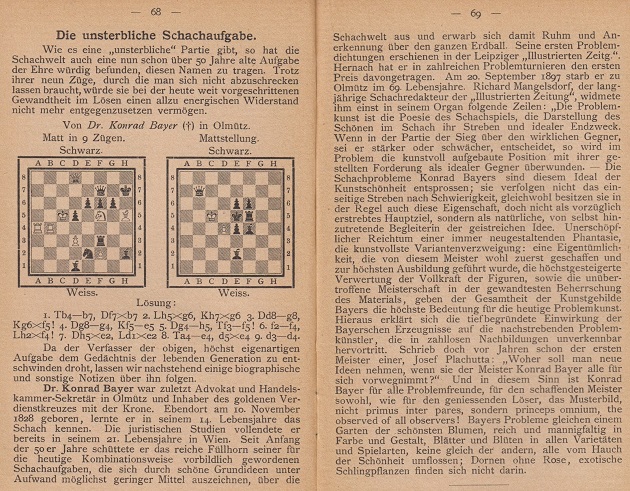
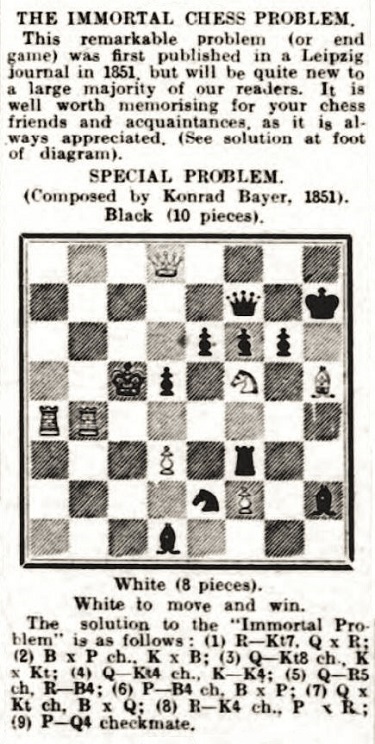
Staffordshire Advertiser, 26 December 1925, page 5
Claims that Bayer’s problem was/has been forgotten are further undermined by its appearance in popular books, e.g. Chernev’s The Bright Side of Chess (page 80) and Reinfeld’s The Joys of Chess (pages 113-114), as well as on page 110 of Tal’s Winning Chess Combinations by Tal and Khenkin – quite apart from all the reference books cited at the start of the present item.
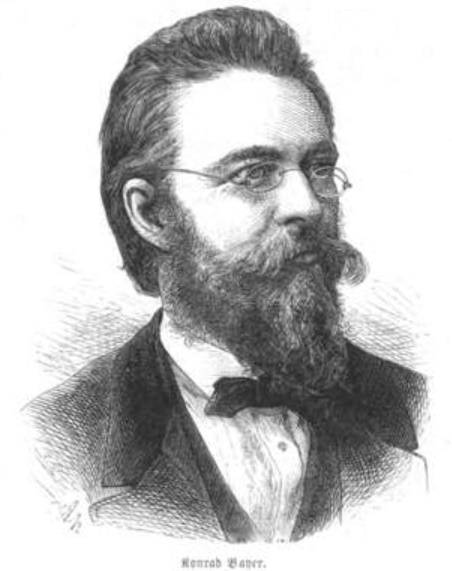
Illustrirte Zeitung, 6 July 1872, page 18.
10398. Morphy and Alekhine
Browsing through 1856 editions of The Era, we came to this composition (20 July, page 14):

The problem’s publication on page 192 of the 15 June 1856 issue of La Régence can be viewed online, and it will be noted that the composer was identified as M. [Monsieur] Wassmann. See Steinitz Stuck and Capa Caught for the story of Morphy requiring over an hour to solve the problem and Alekhine finding the solution immediately.
10399. Photographic archives (26)
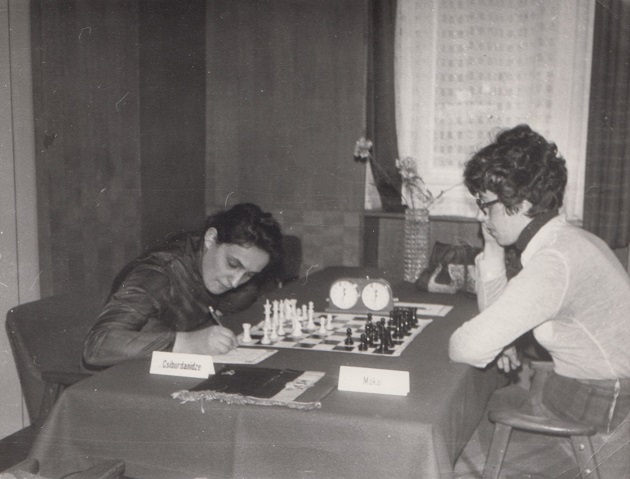
Maia Chiburdanidze and Suzana Makai
We believe that the photograph was taken in Budapest, and details about the exact occasion are sought. Suzana Makai (1945-87) was born in Romania but in the latter part of her life was resident in Hungary. A brief notice of her death is on page 24 of Europe Echecs, July-August 1987.
10400. Schuster v Carls
Concerning the Schuster v Carls miniature, Alan McGowan (Waterloo, Canada) notes that the moves ‘10 c3 (Dd2, gf2:+)’ were mentioned on pages 211-212 of the November 1931 issue of Schachwart (edited by Kurt Richter):


10401. Boomerang combination (C.N.s 9489 & 9498)
On the question of whether the loser of a famous combination was named Mai or May, Mr McGowan notes a crosstable on page 91 of the May 1932 Schachwart which has both ‘Fr. Mai’ and ‘H. May’:
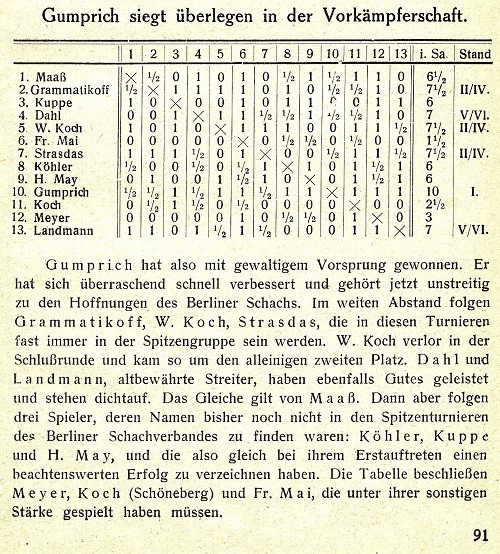
10402. The Immortal Problem (C.N. 10397)
C.N. 10397 quoted a comment by D.J. Morgan about Konrad Bayer’s problem on page 200 of the July 1960 BCM, and Michael McDowell (Westcliff-on-sea, England) points out that very similar words had appeared on pages 113-114 of The Chess Problem by H. Weenink (Stroud, 1926):

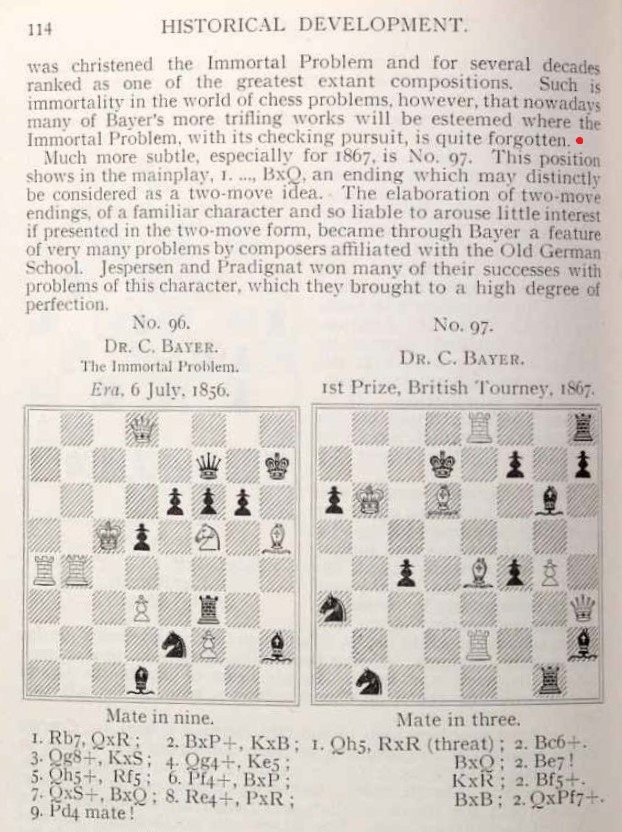
10403. Sources for compositions
Reviewing Chernev’s The Bright Side of Chess on pages 357-358 of the December 1952 BCM, D.J. Morgan concluded:

Below is what had appeared on page 80 of Chernev’s book:
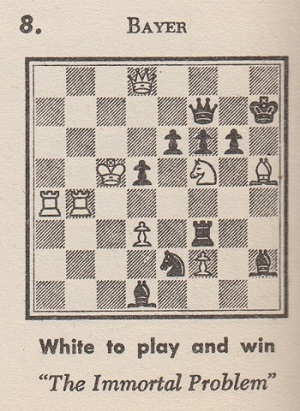
Another example of a minimalist approach to sources is on page 180 of The Fireside Book of Chess by I. Chernev and F. Reinfeld (New York, 1949):
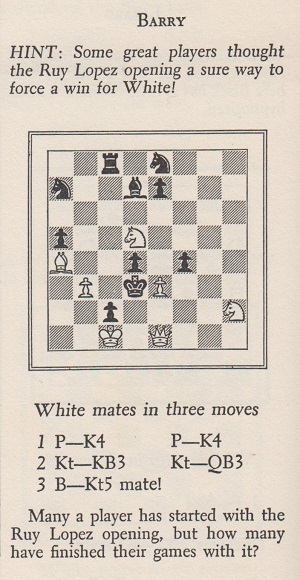
We note that the three-mover was by Henry William Barry and was published on page 250 of the December 1915 American Chess Bulletin:

Can any other chess composition be found whose solution corresponds to the moves of an opening?
| First column | << previous | Archives [152] | next >> | Current column |
Copyright: Edward Winter. All rights reserved.